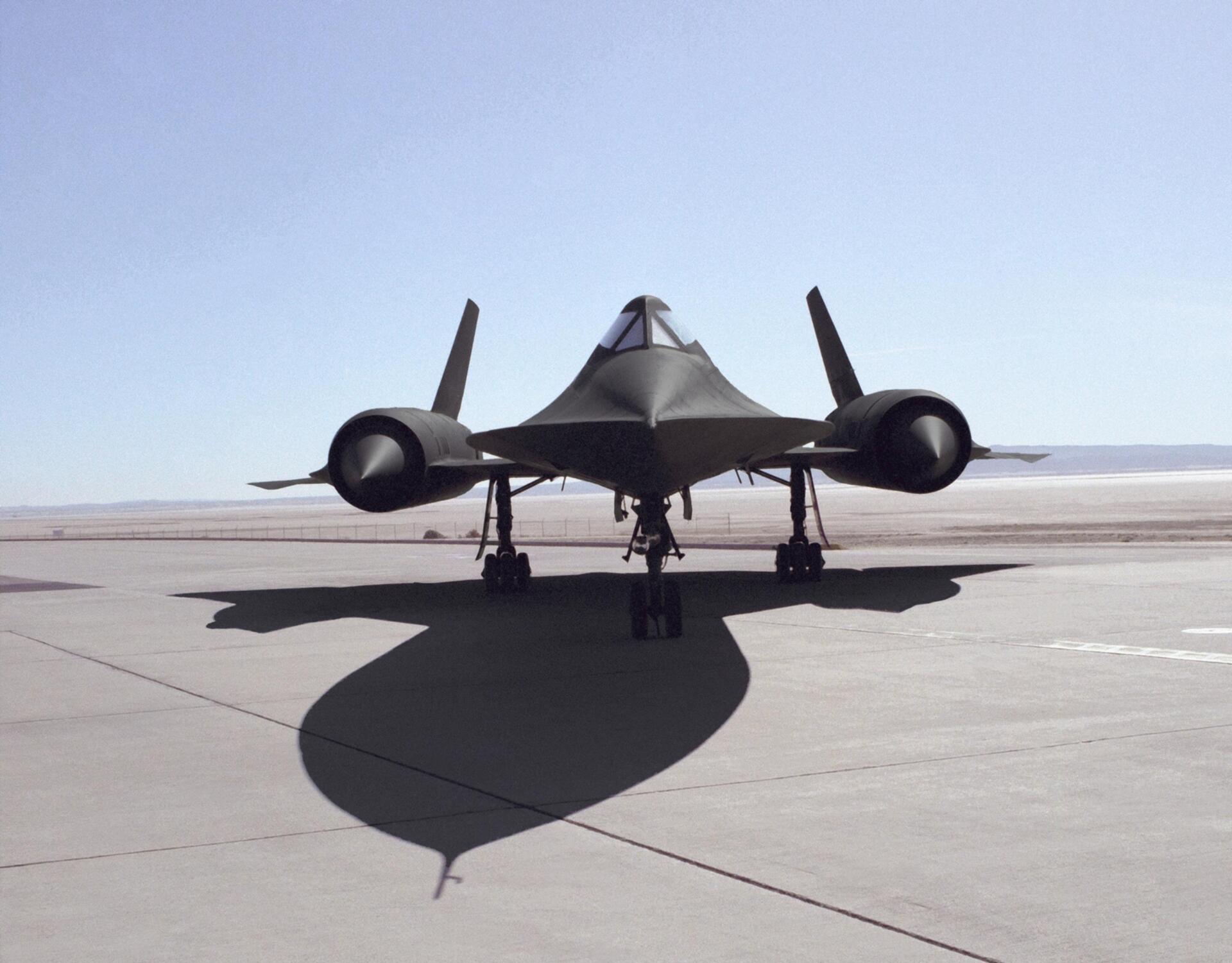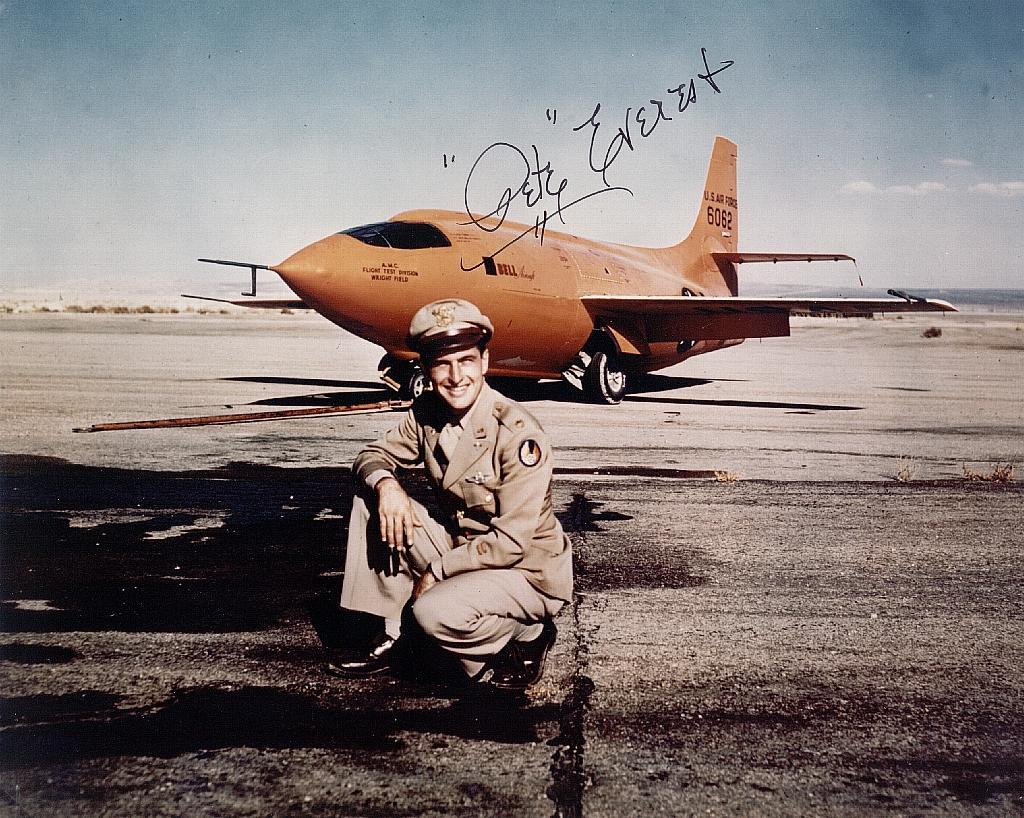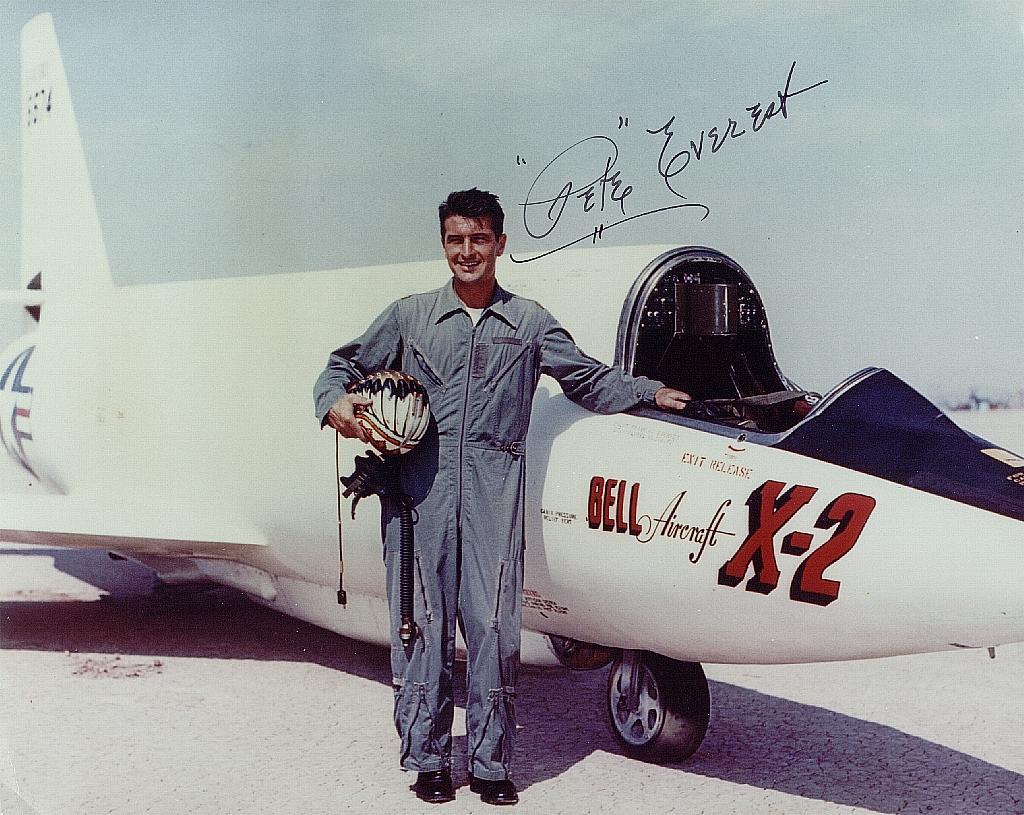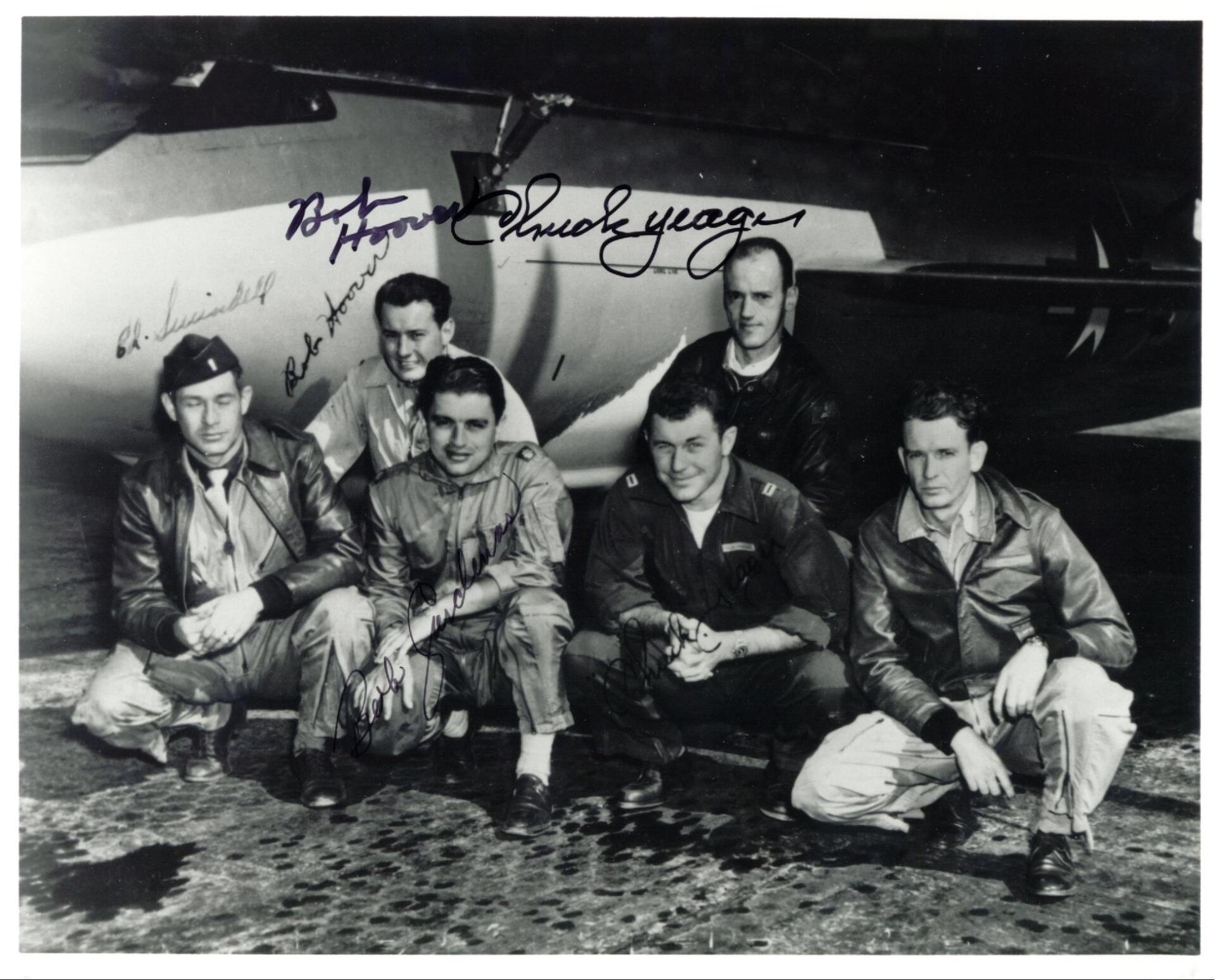Menu
Brigadier General Frank K. "Pete" Everest USAF ret. - (1920-2004)
Slide title
Pete Everest with the X-1 - 10 Flights - 2 Flights
Button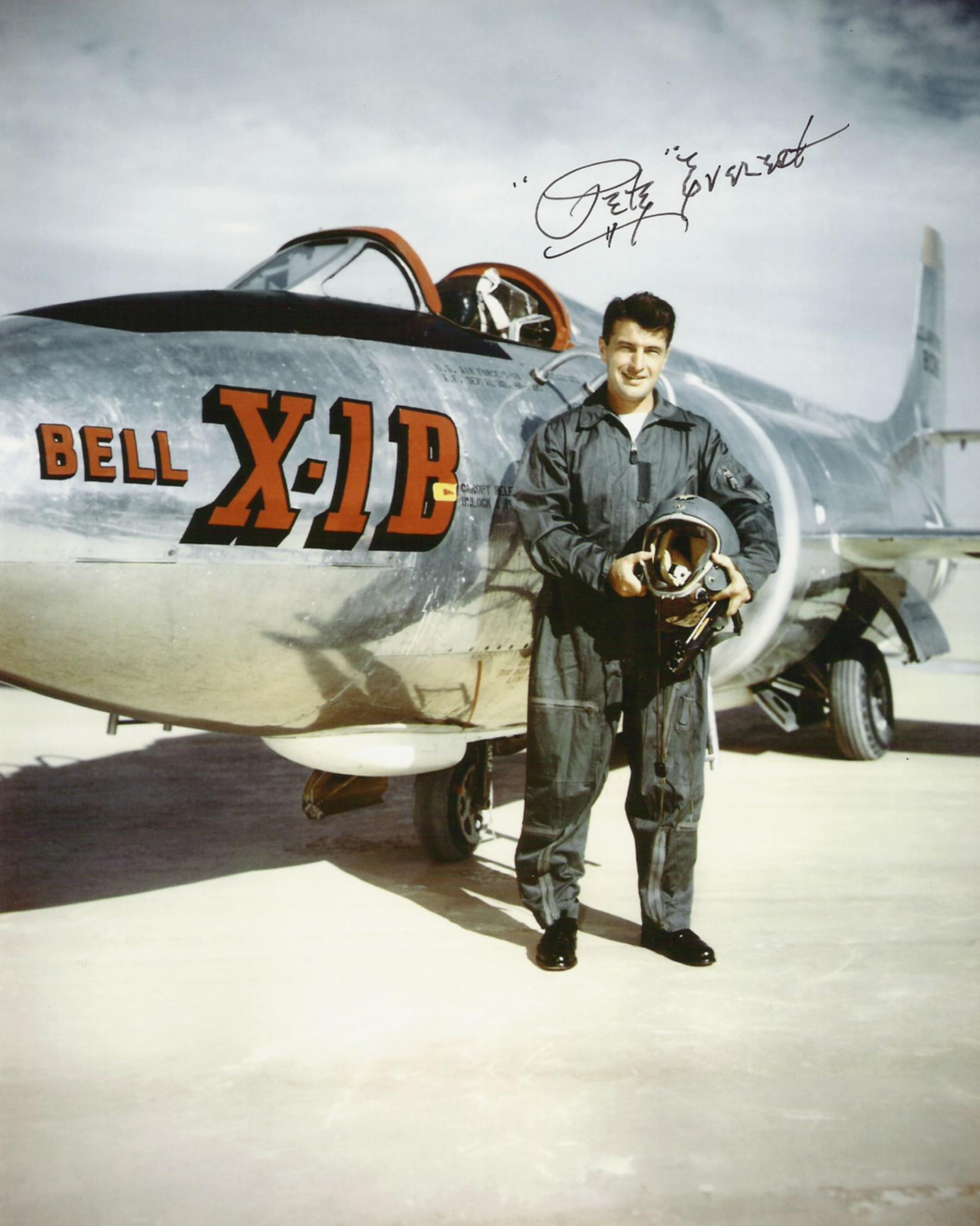
Slide title
Bell X-1B
Button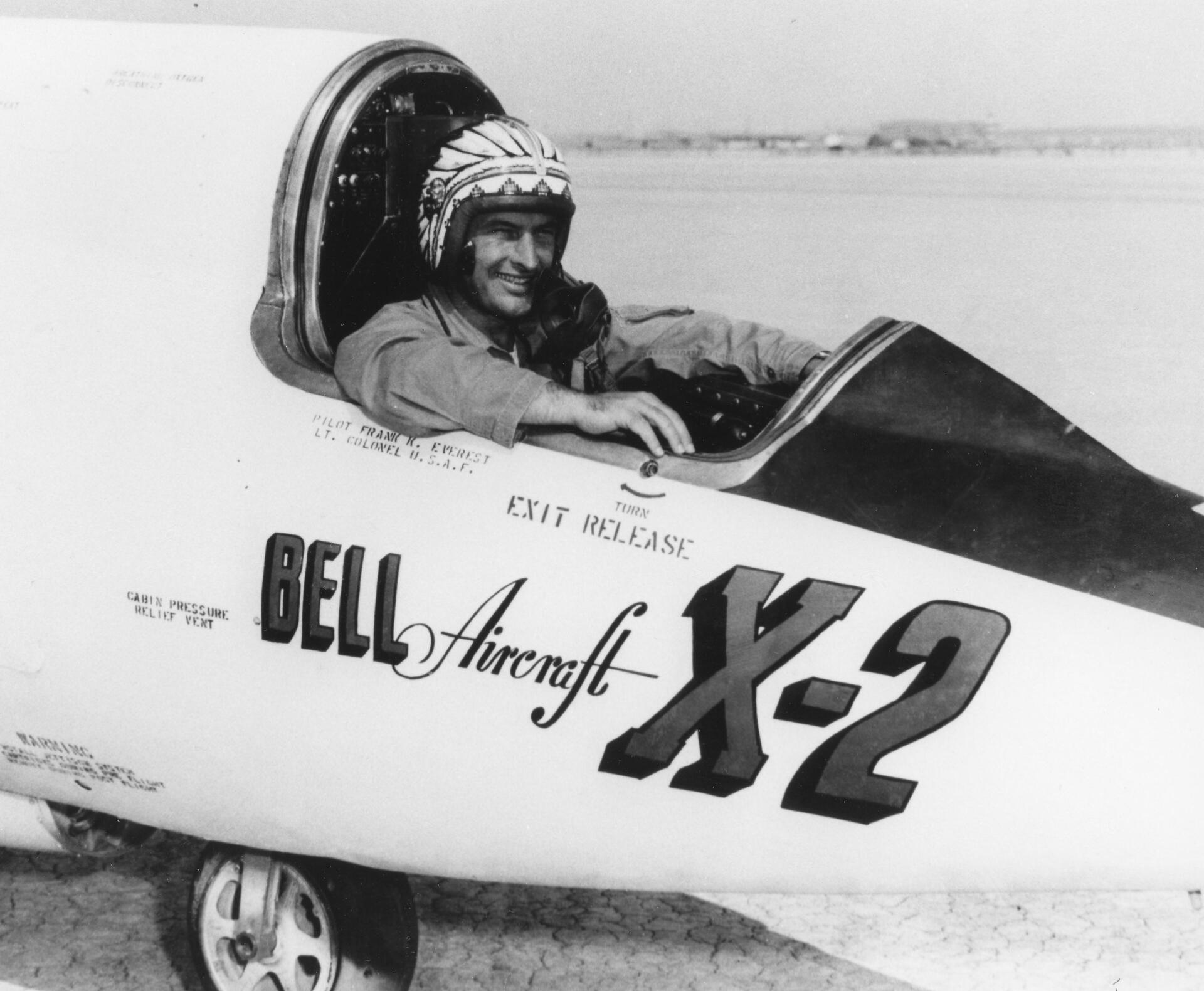
Slide title
In the cockpit of the Bell X-2 - 13 Flights
ButtonSlide title
With the X-2
Button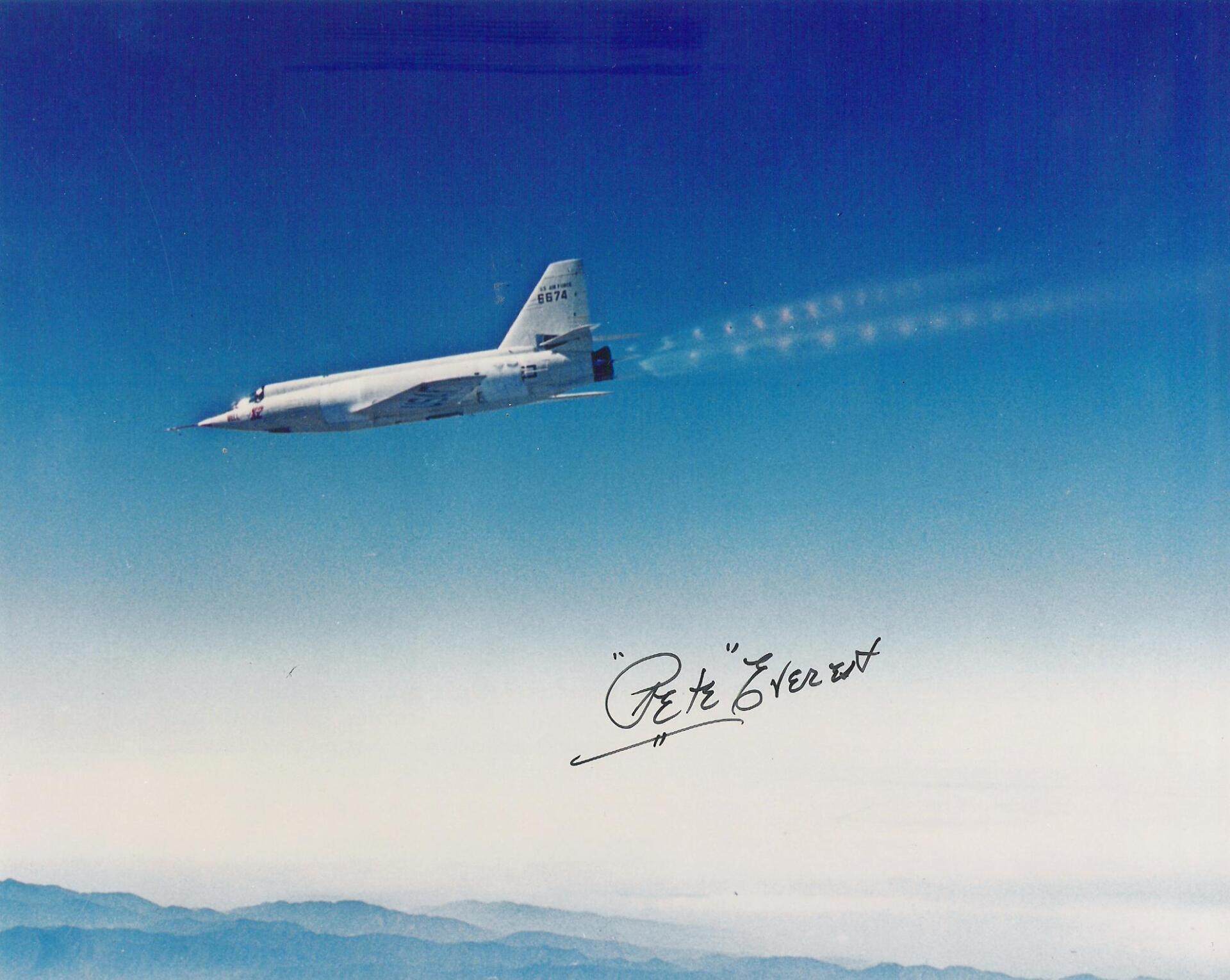
Slide title
Bell X-2 in flight
Button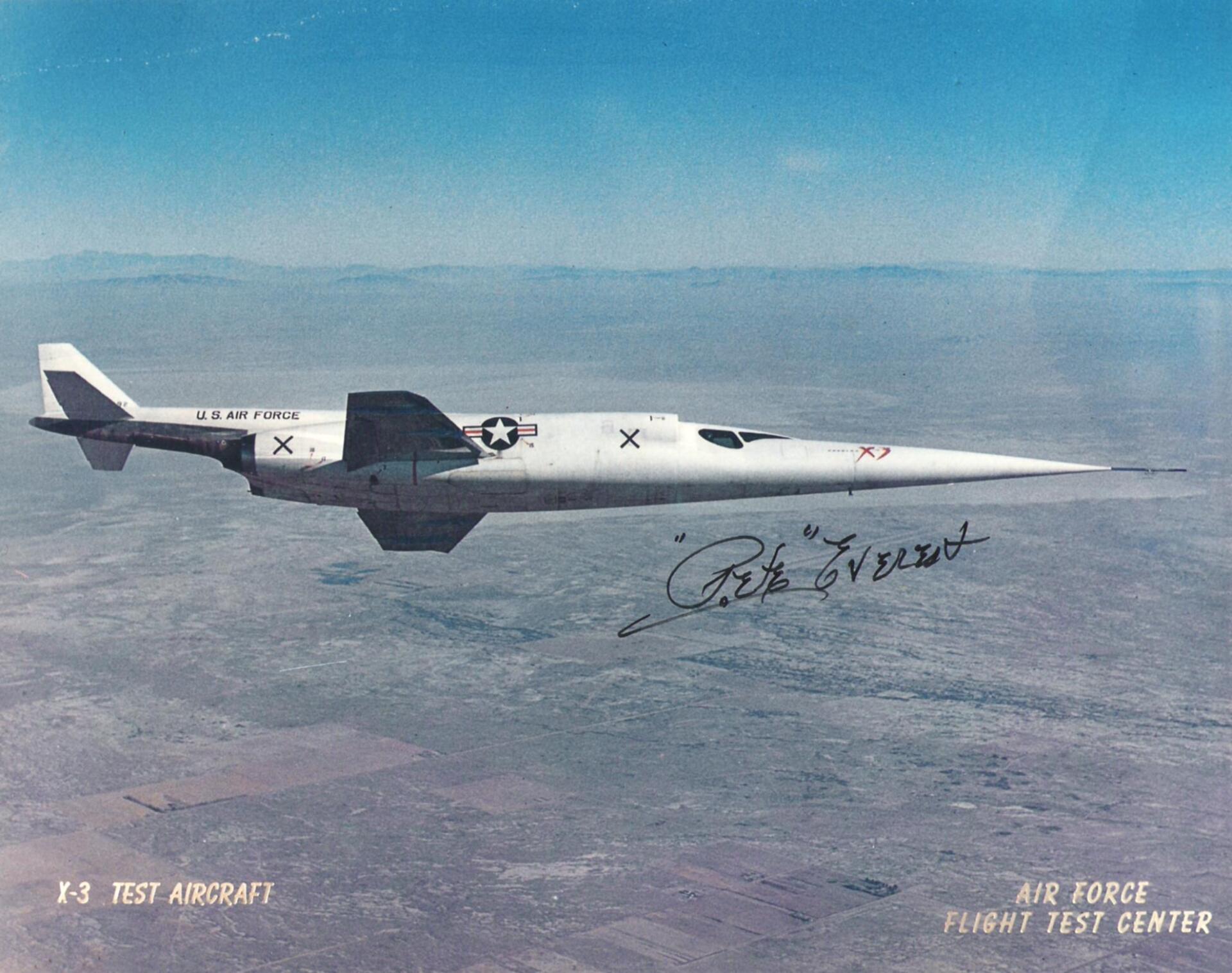
Slide title
Douglas X-3 Stiletto - 3 Flights
Button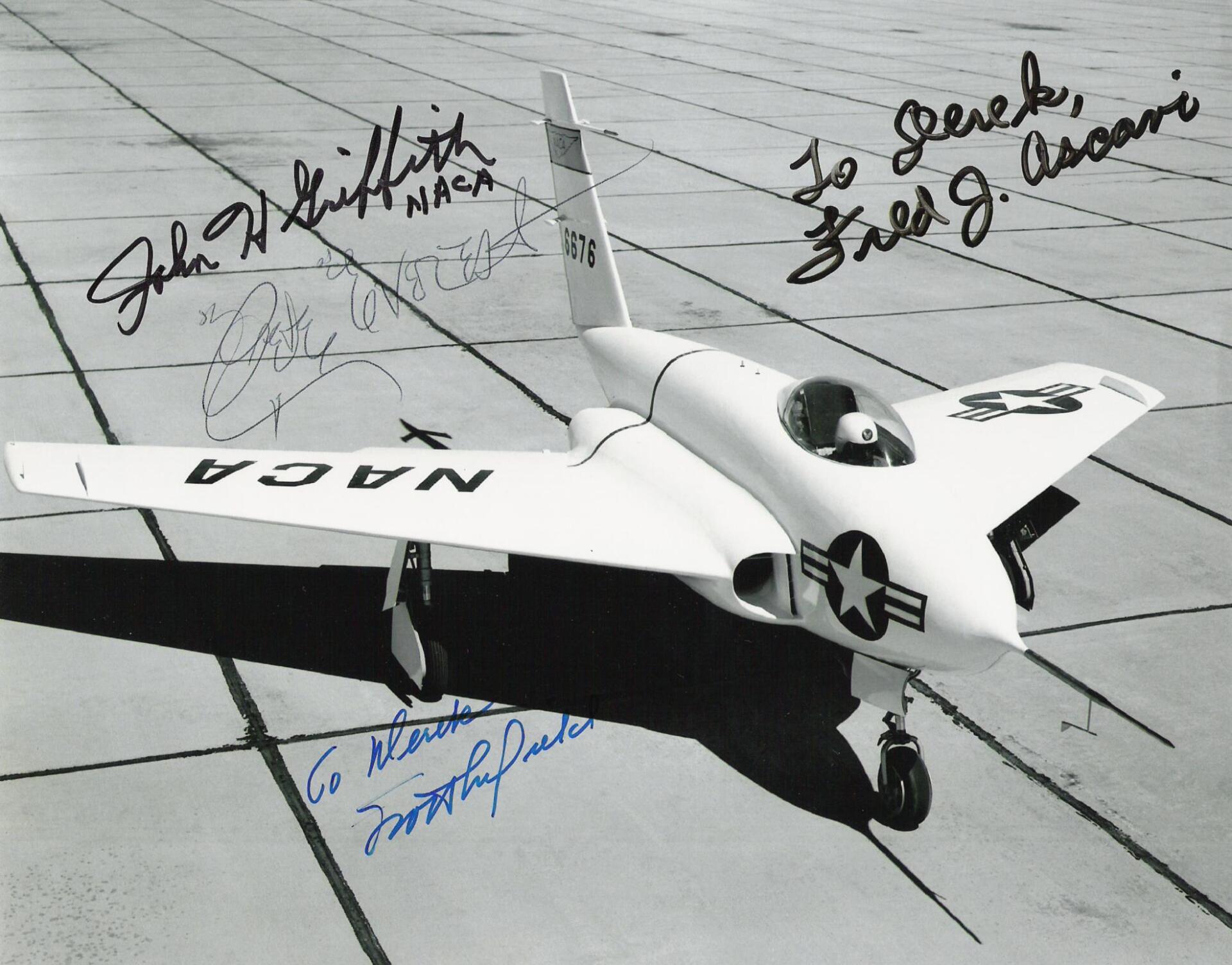
Slide title
Northrop X-4 Bantam - 4 Flights
Button
Slide title
Bell X-5 - 6 Flights
Button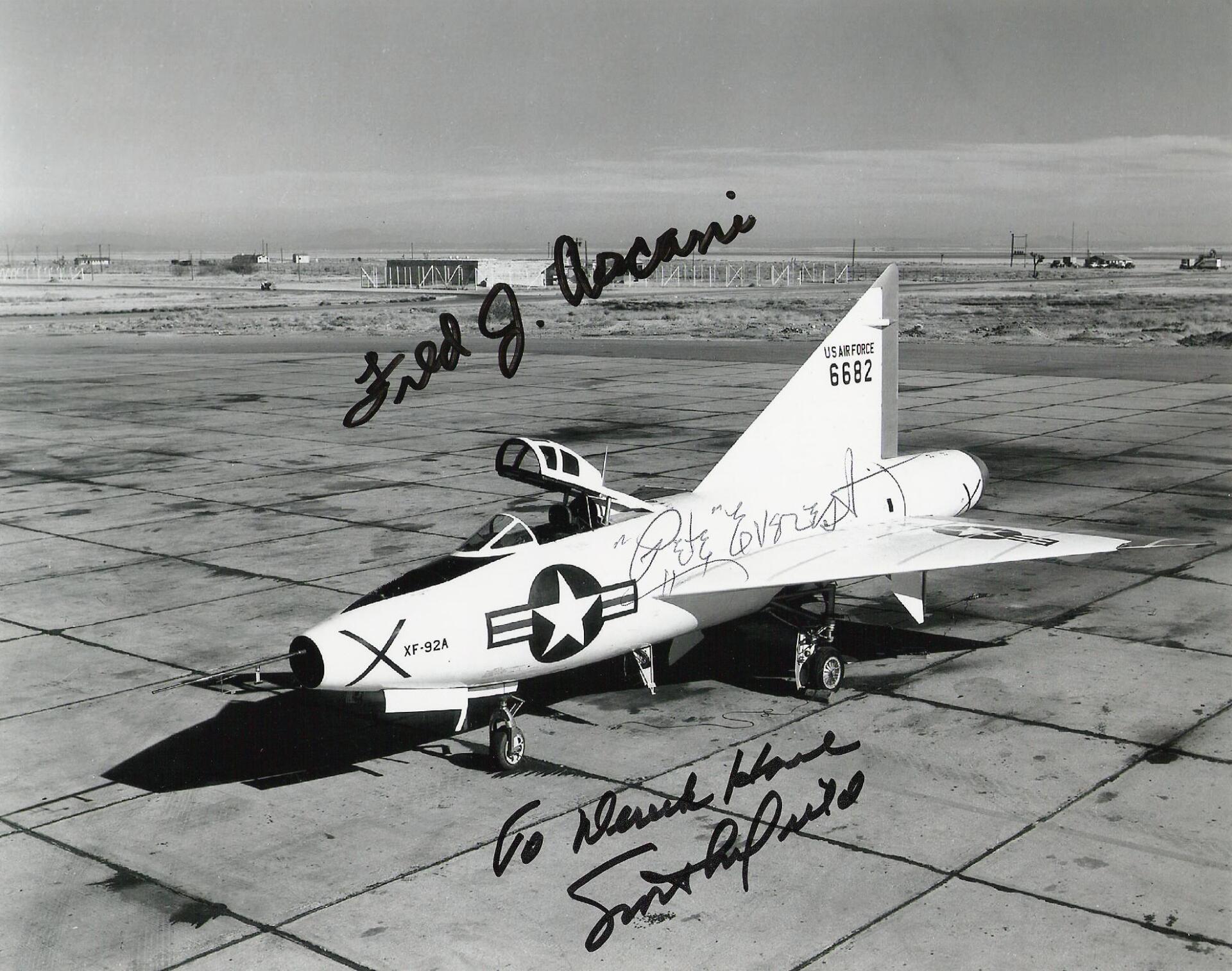
Slide title
Convair XF-92A - 12 Flights
Button
Slide title
Write your caption hereButton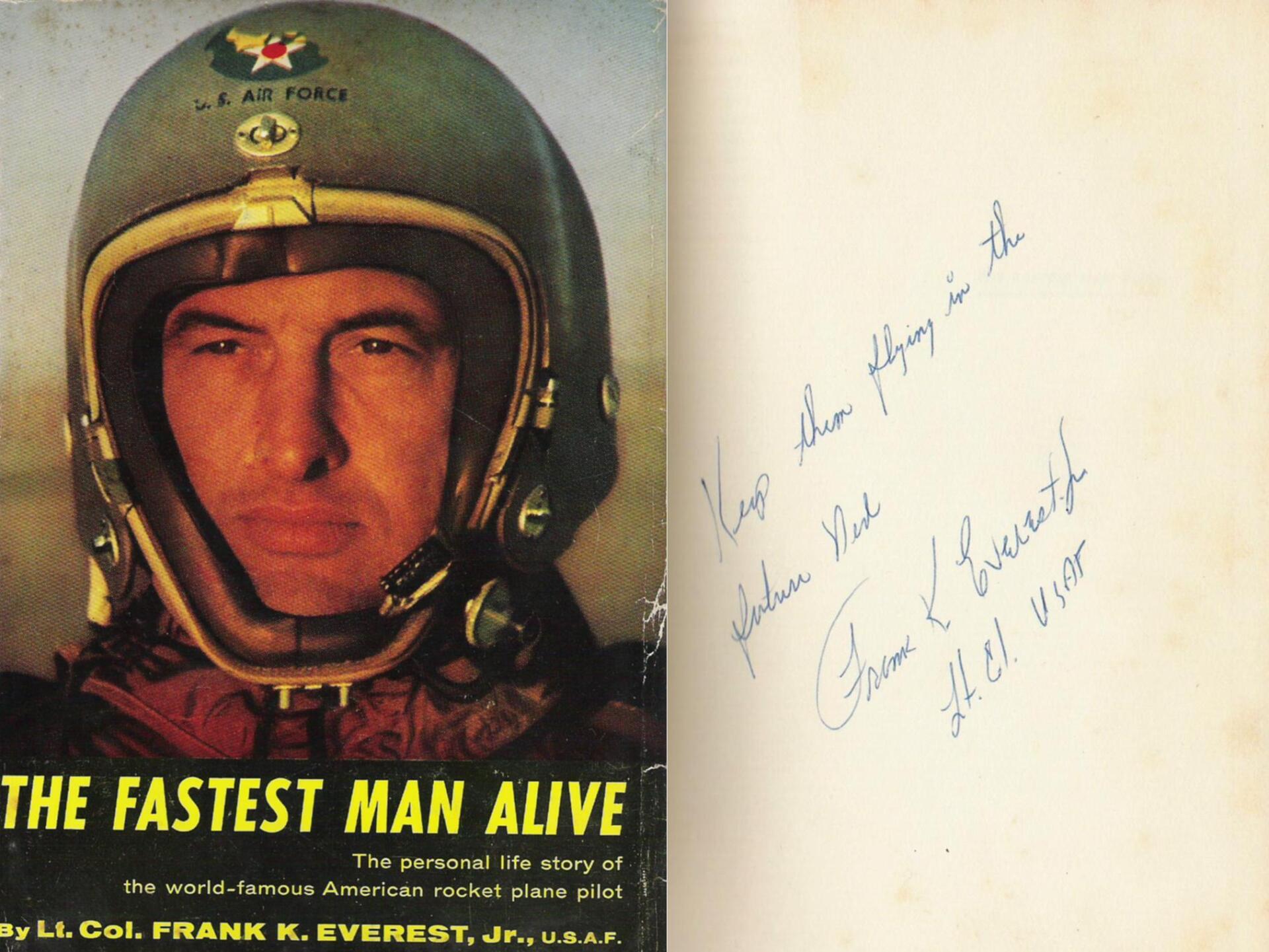
Slide title
Signed copy of "The Fastest Man Alive" from my collection
Button
General Everest is a combat veteran of WWII where he fought in the China-Burma-India Theater of Operations where he commanded the 17th Fighter Squadron of the 5th Fighter Group at Chinkiang, China. As a test pilot, Everest tested the X-1, X-1B, X-2, X-3, X-4 and X-5 (the only pilot to fly X-1 through X-5) and in doing so set a world altitude record in the X-1 and followed that up with a speed record in the X-2 (Mach 2.87). He is the only X-2 pilot who lived to see retirement after the demise of Bell Chief Test Pilot Skip Zieger who was killed when the X-2 exploded over Lake Ontario in 1953; the fatal crash of the X-2 which claimed the life of Capt. Mel Apt on 27th September 1956. This was Apt's only flight and he reached Mach 3.196 before encountering inertia coupling. Iven Kincheloe (who set an altitude record of 126,200 feet in the X-2) was killed when ejecting from his F-104 Starfighter. Read the Wikipedia biography of General Everest.
Richard H. "Dick" Frost - (1916-1996)
Slide title
The X-1 team that broke the sound barrier - Frost is behind Chuck Yeager
Button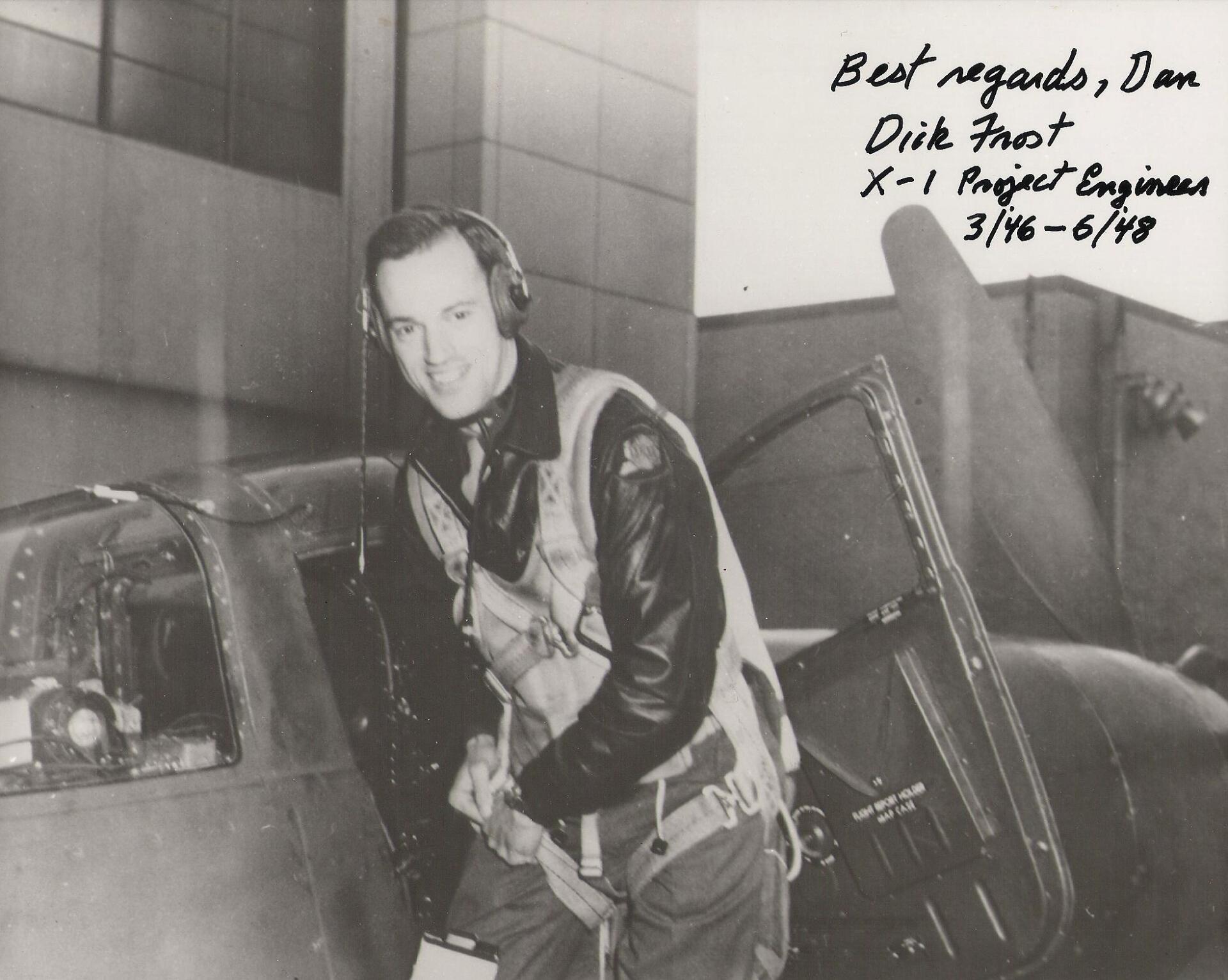
Slide title
Dick Frost with Bell P-63
Button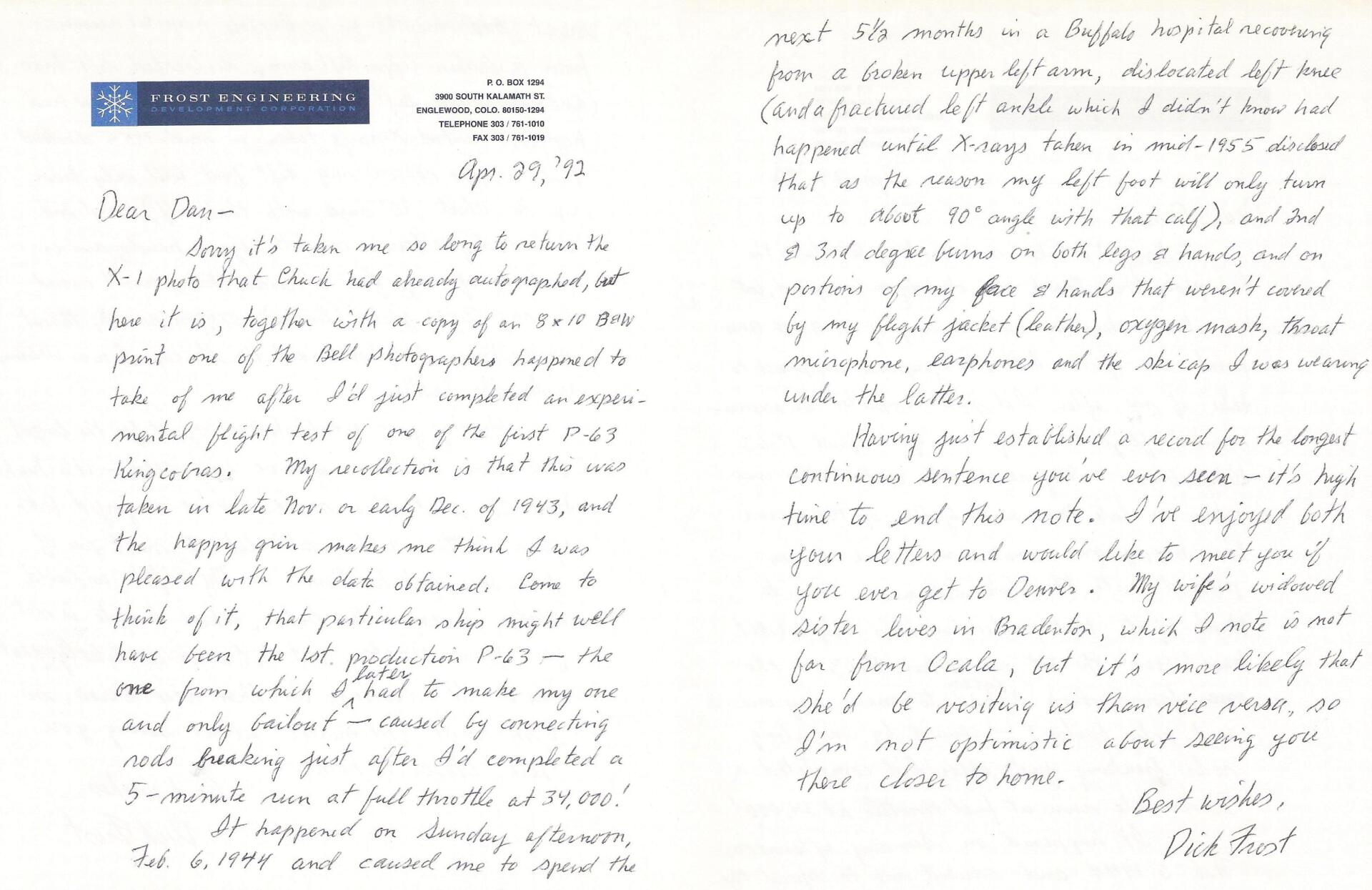
Slide title
Dick Frost letter
Button
Richard Frost was a key member of the team that made the greatest advances in aviation since the Wright brothers opened the age of powered flight at Kitty Hawk in 1903. The young boy born in 1916 in Ohio, just a few miles east of the cradle of aviation, would eventually help advance aviation into the world of supersonic flight. Frost began his studies at a small liberal arts college, then went on to earn a Bachelor of Science degree in Aeronautical Engineering from the highly respected Rensselaer Polytechnic Institute in 1940. As a student, he worked towards his pilot's license, bought an old Gypsy Moth trainer, and used it to earn money. After graduation, he worked in Brownsville, Texas for a short time as an engineer for Pan American Airways Systems. In 1941, he became Chief Engineer for Arens Controls, Inc., Chicago, Illinois. Frost was responsible for design, development, and production of mechanical remote control systems. In 1943, the young engineer got the opportunity of a lifetime and began working for Bell Aircraft corporation, Niagara Falls, New York. He quickly became a well-respected and accomplished test pilot, flying Bell's P-39 Airacobra, P-63 Kingcobra and P-59 Airacomet fighters. In February 1945, Frost had to bail out of a burning P-63; severe burns on his hands grounded him until late in the year. When the project engineer on the top secret X(S)-1 rocket airplane was assigned to another project, Frost was tapped to replace him and supervise the installation and checkout of the Reaction Motors XLR-11 rocket power plant. He then nursed the exotic aircraft through its contractor-powered flight program. When the Army Air Corps began its test program in midsummer 1947, Frost routinely flew low chase on the X(S)-1 in a Lockheed RF-80. He was one of the few men privileged to witness, from close range, Captain Chuck Yeager's historic flight through the sound barrier on October 14, 1947.
In 1949, he left Bell to work for the Stanley Aviation Corporation, Denver, Colorado. He helped design an extraordinarily thin wing, and other modifications for X(S)-1 #2. This aircraft, re-designated the X-1 E, completed 26 flights before being grounded in November 1958. Frost continued his work at Stanley Aviation until 1960, when he became the founding president of Frost Engineering Development Corporation, Englewood, Colorado. The company now specializes in the manufacturing of life support equipment for military and civilian aircraft and crew. Today's pilots who fly the General Dynamics F-16 rely on products that resulted from this aviation pioneer's genius.
Colonel C. Gordon Fullerton USAF ret. - (1936-2013)

Slide title
Gordon Fullerton - NASA Portrait
Button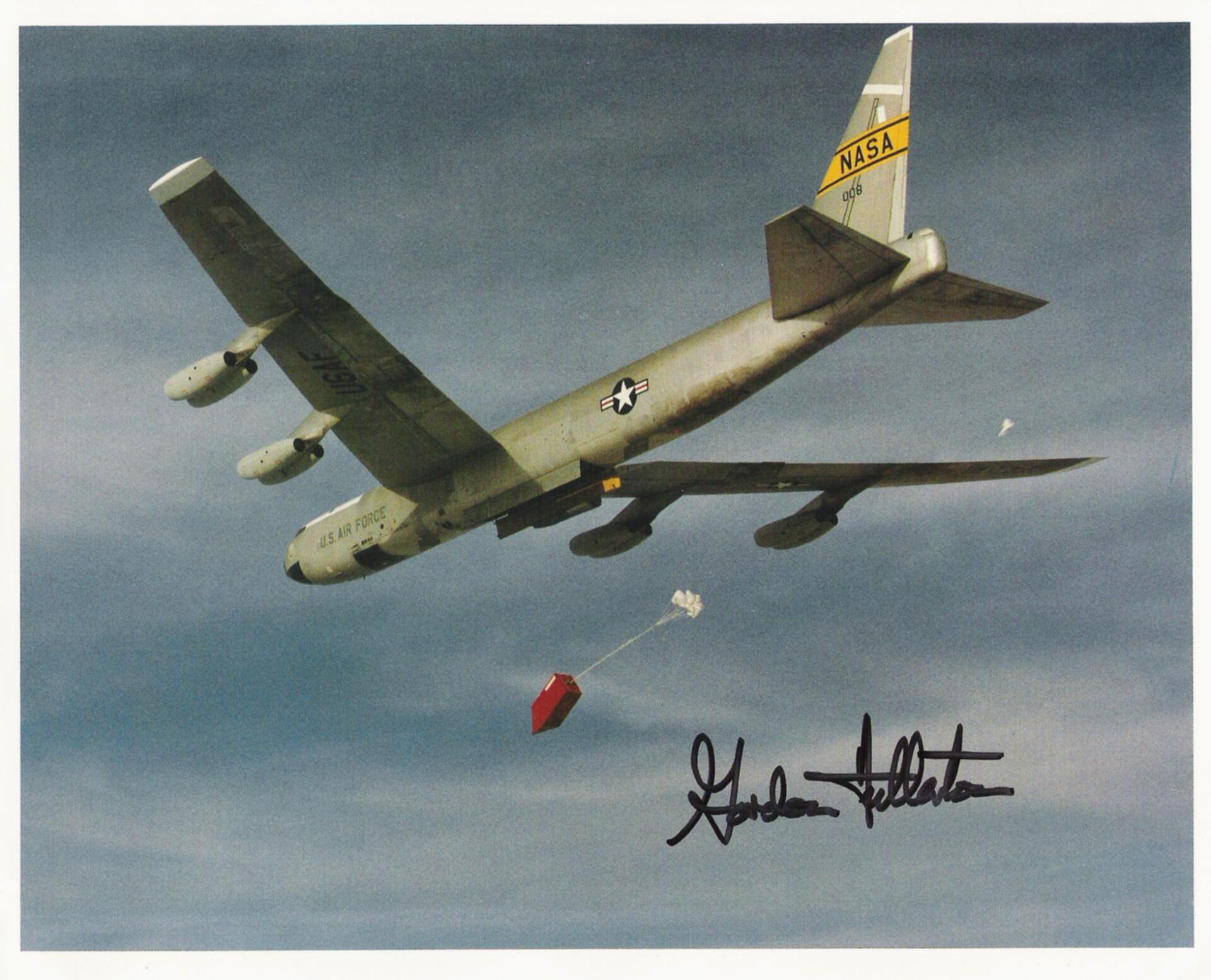
Slide title
B-52 with F-111 Ejection Capsule
Button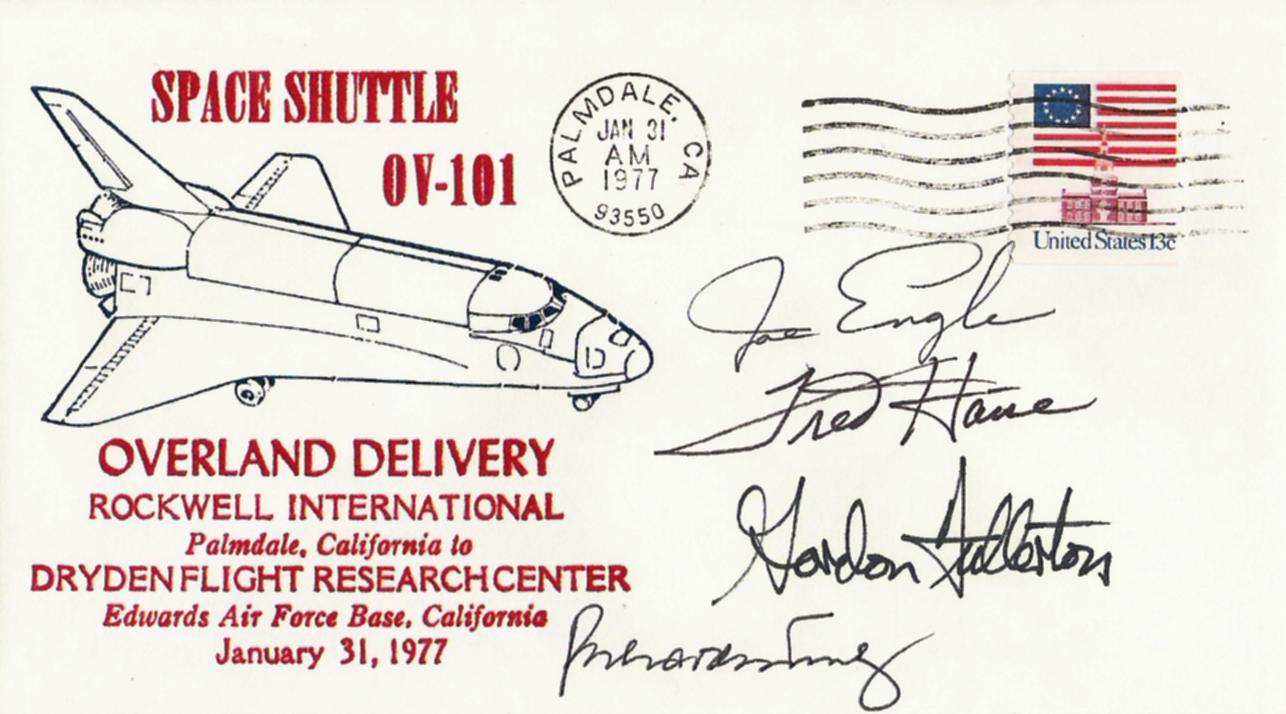
Slide title
Enterprise delivery cover
Button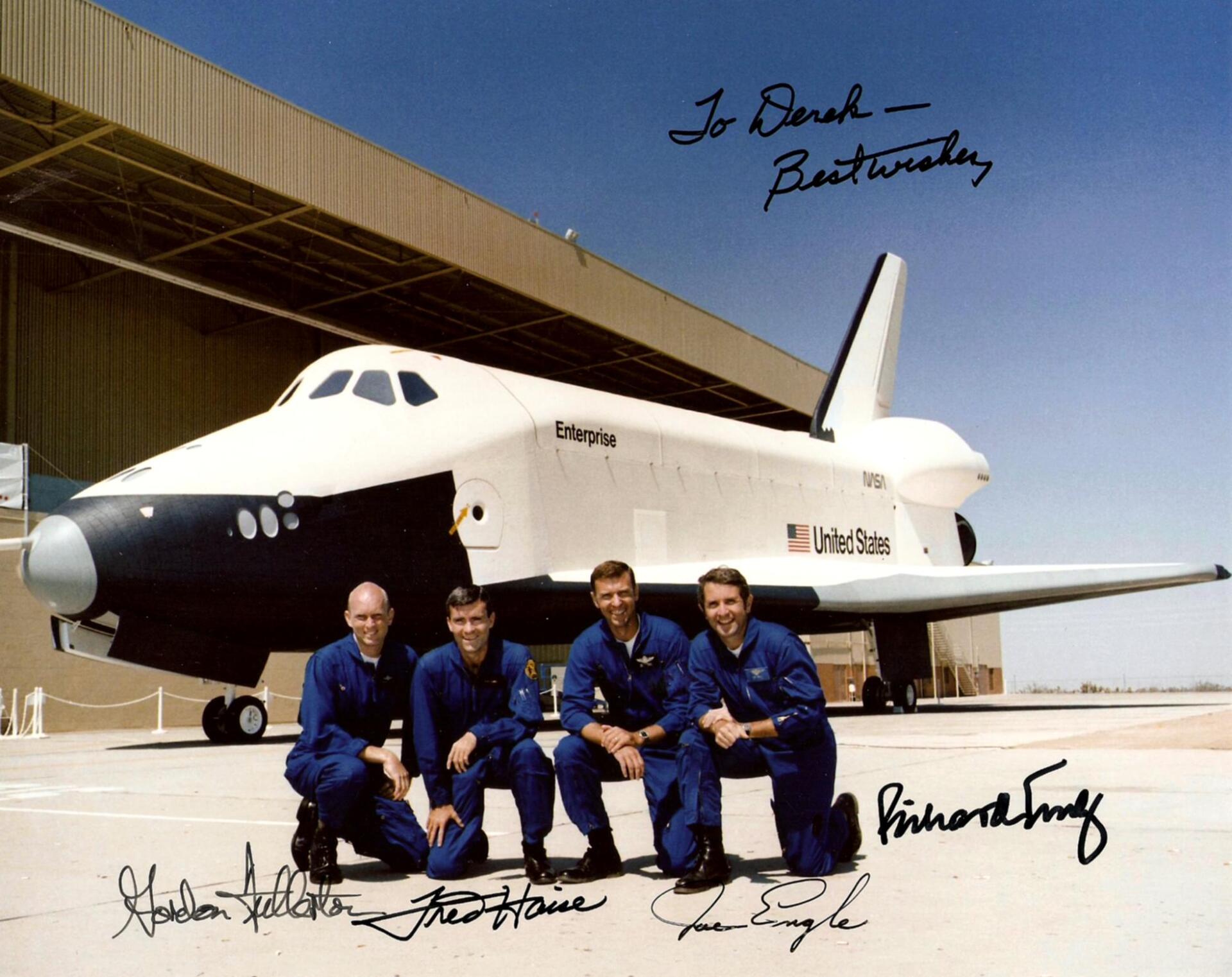
Slide title
Enterprise Approach & Landing Test crews; Fred Haise/Gordon Fullerton & Joe Engle/Richard Truly
Button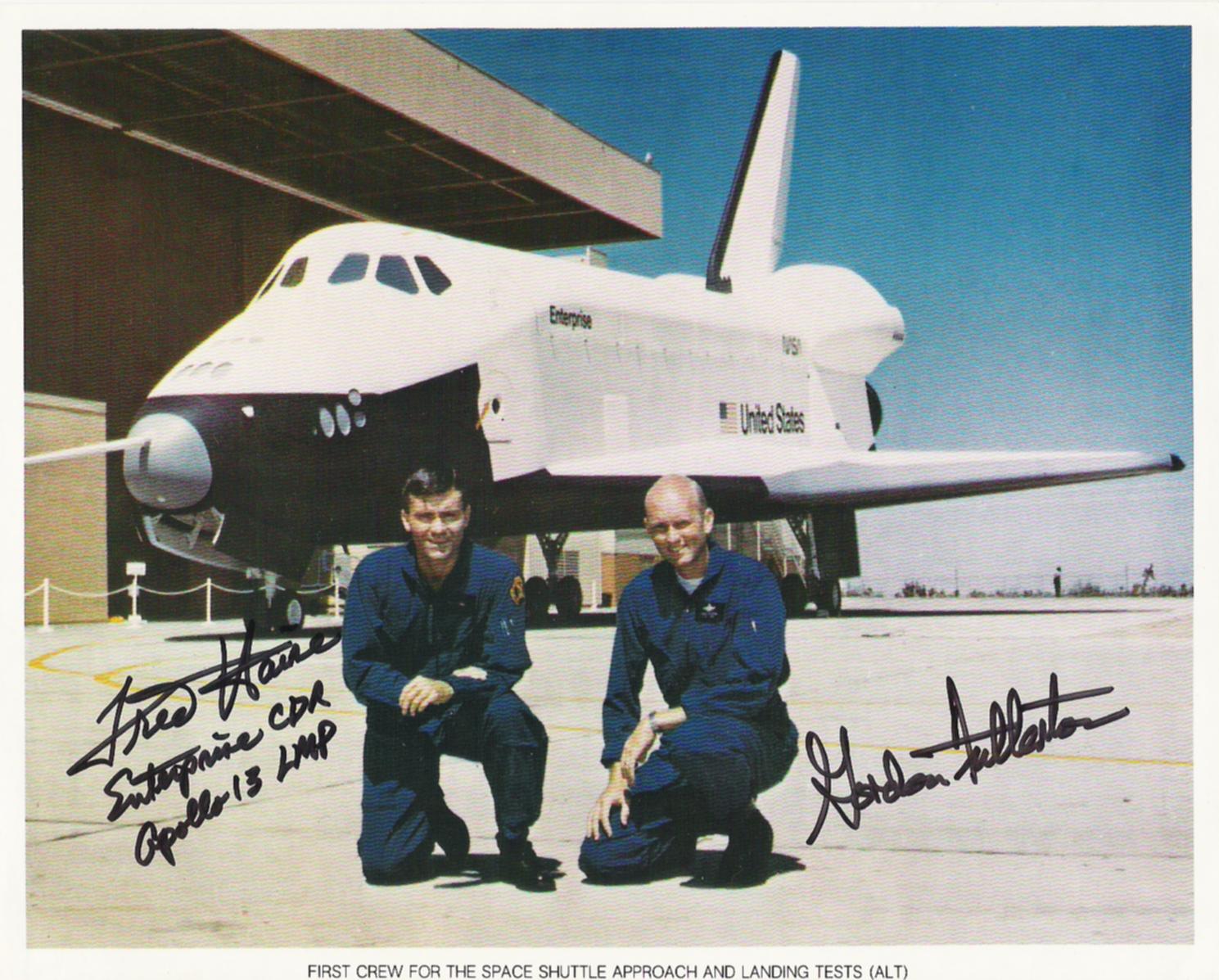
Slide title
Haise & Fullerton with Enterprise
Button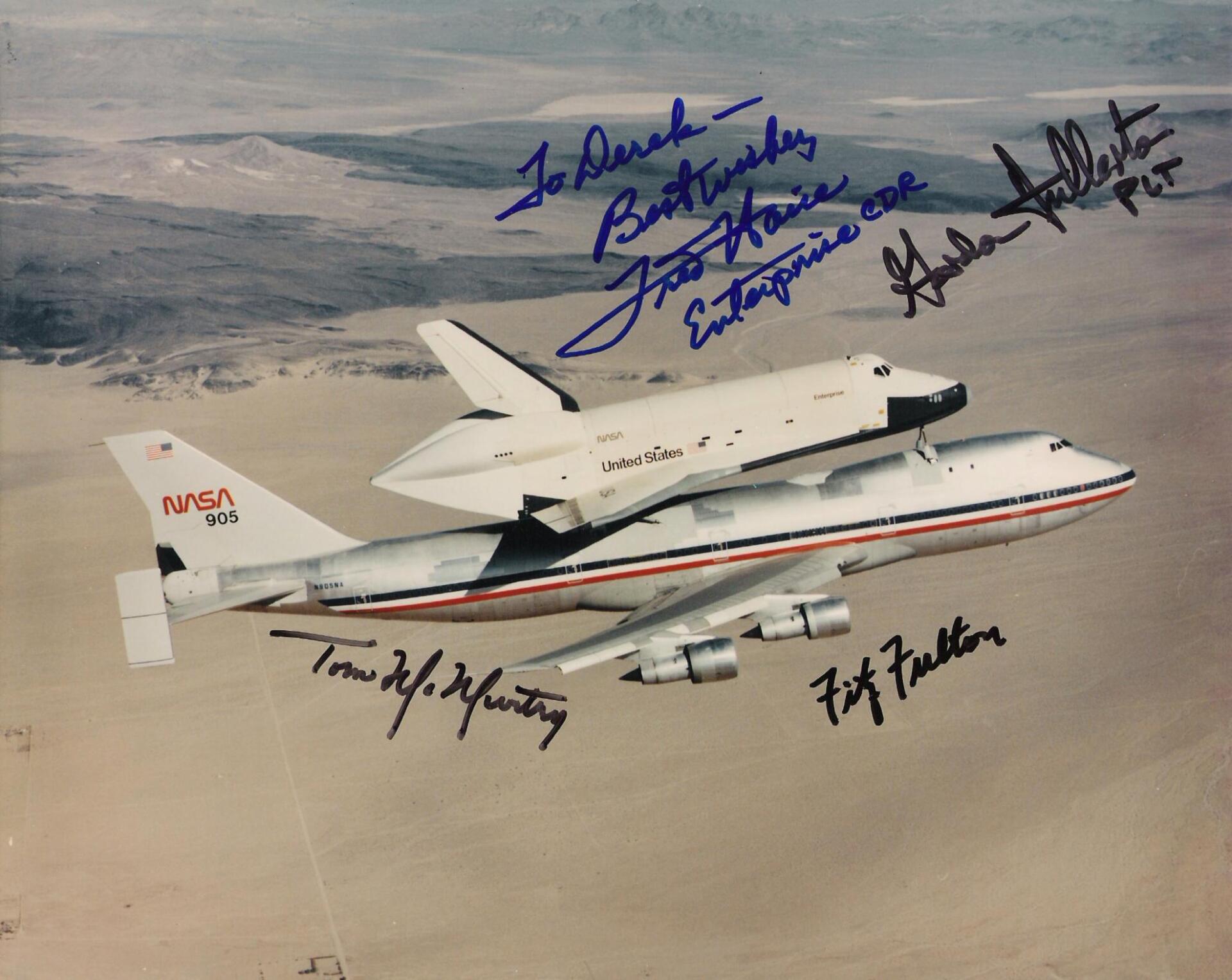
Slide title
First flight of the Enterprise. Signed by Enterprise crew (Haise/Fullerton) and 747 SCA crew (Fulton/McMurtry)
Button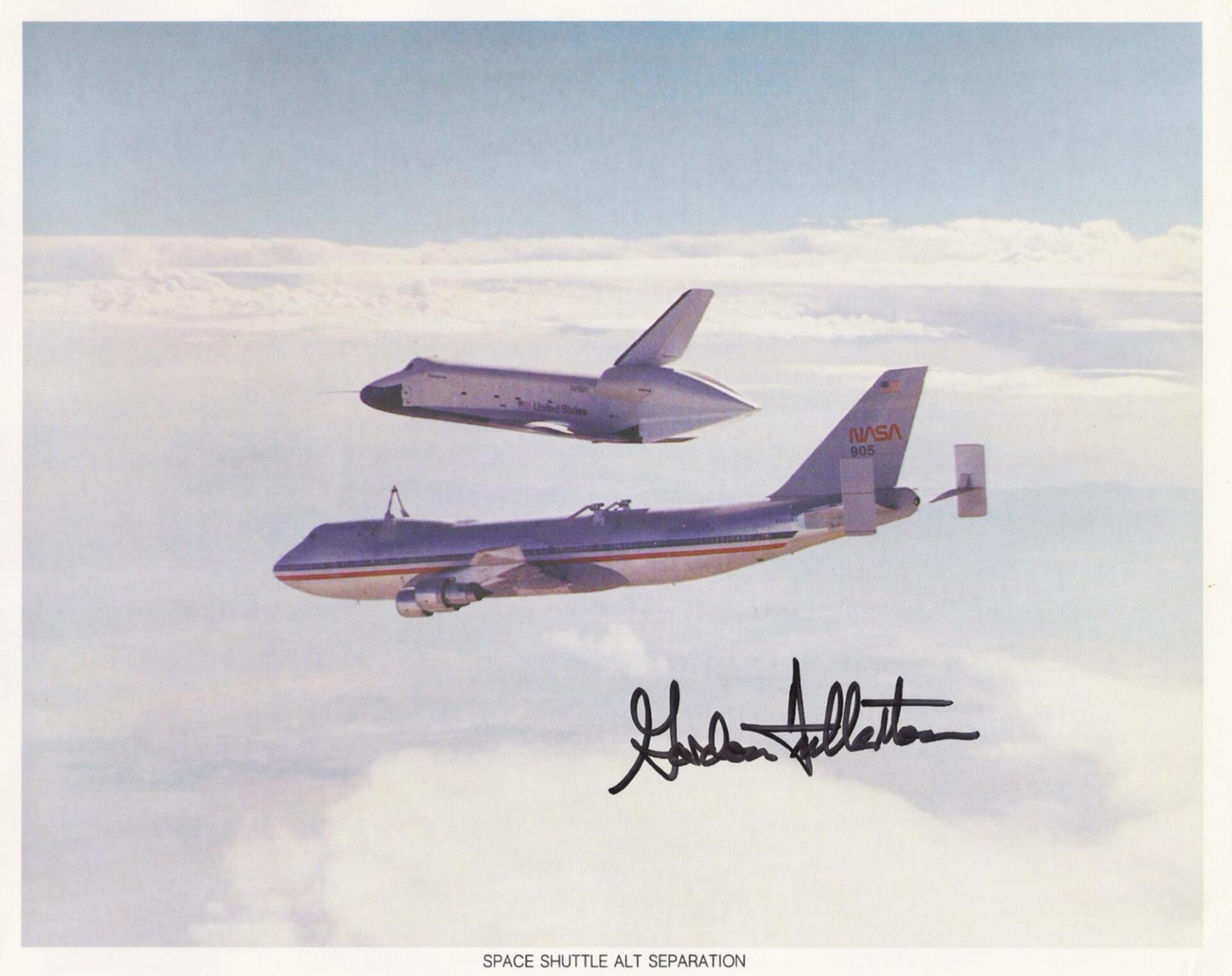
Slide title
Space Shuttle ALT seperation
Button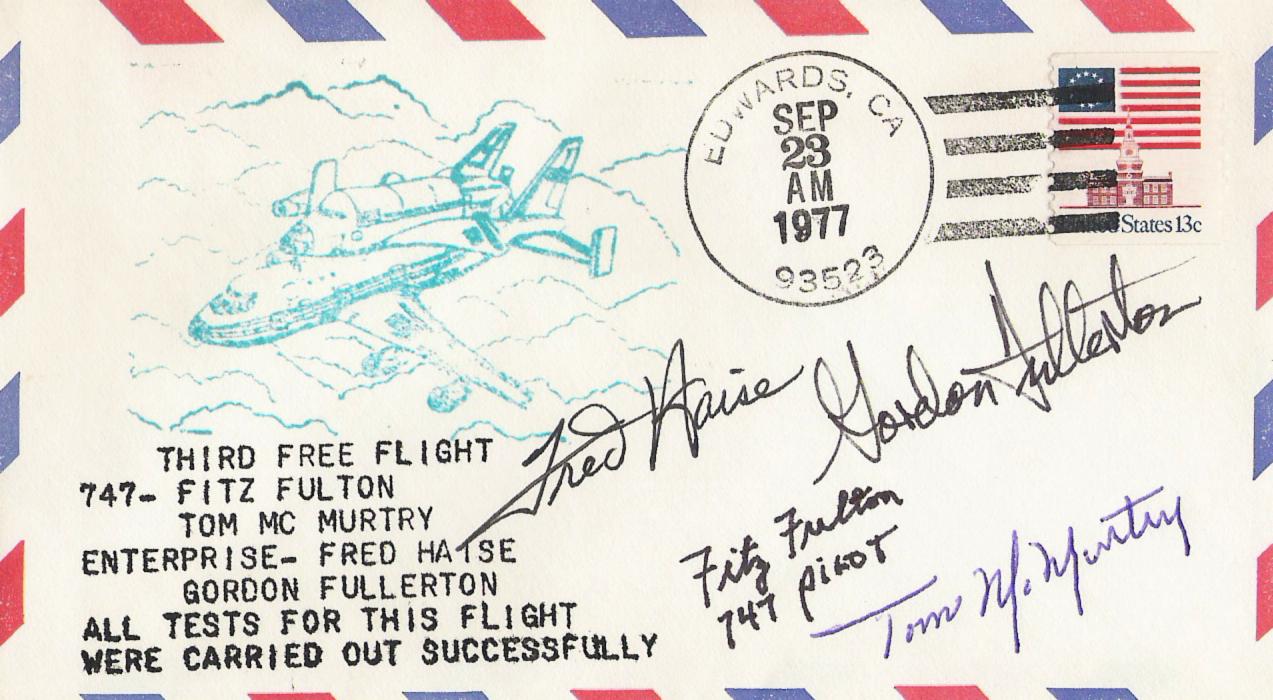
Slide title
3rd Free Flight cover
Button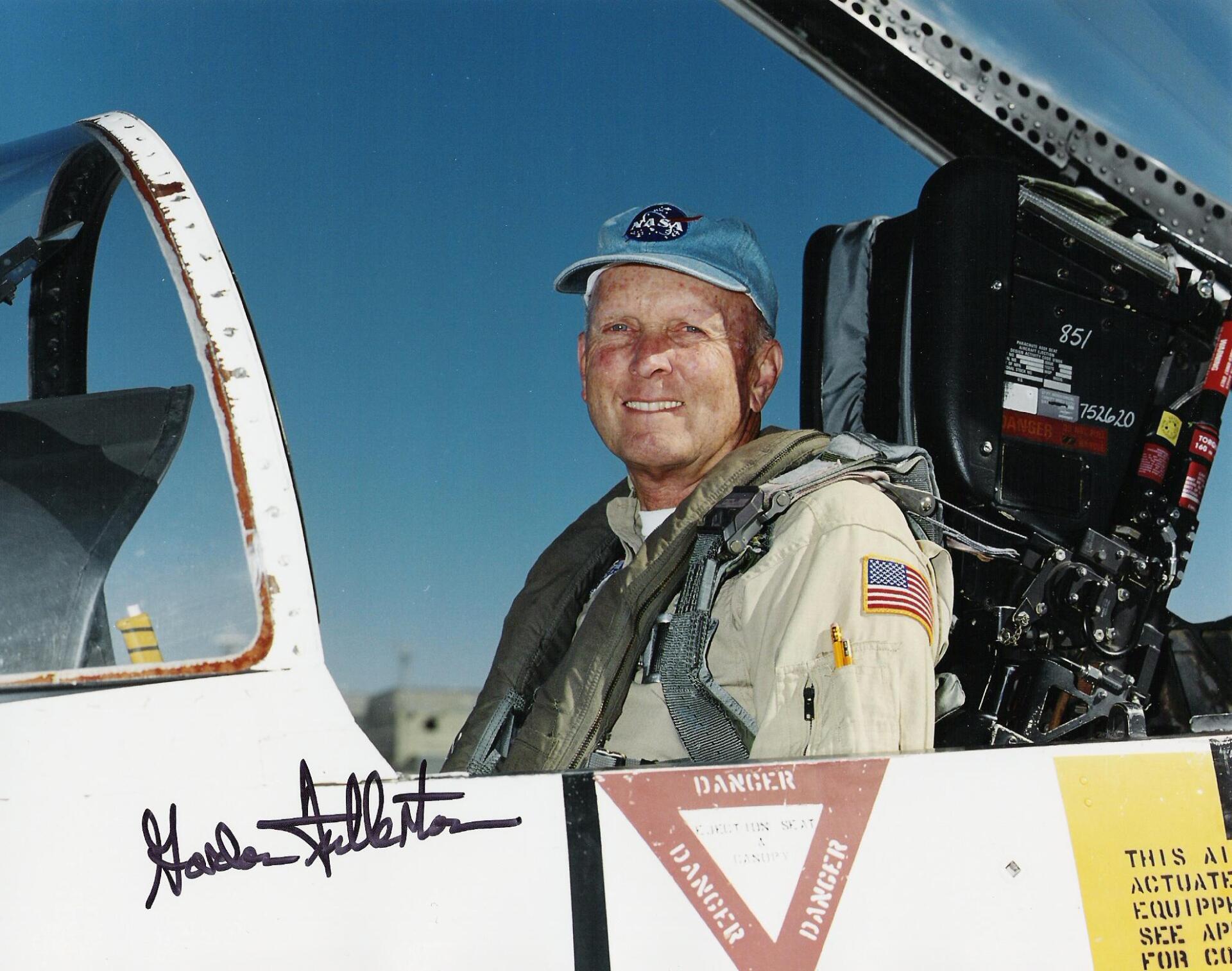
Slide title
Gordon Fullerton in T-38 Cockpit
Button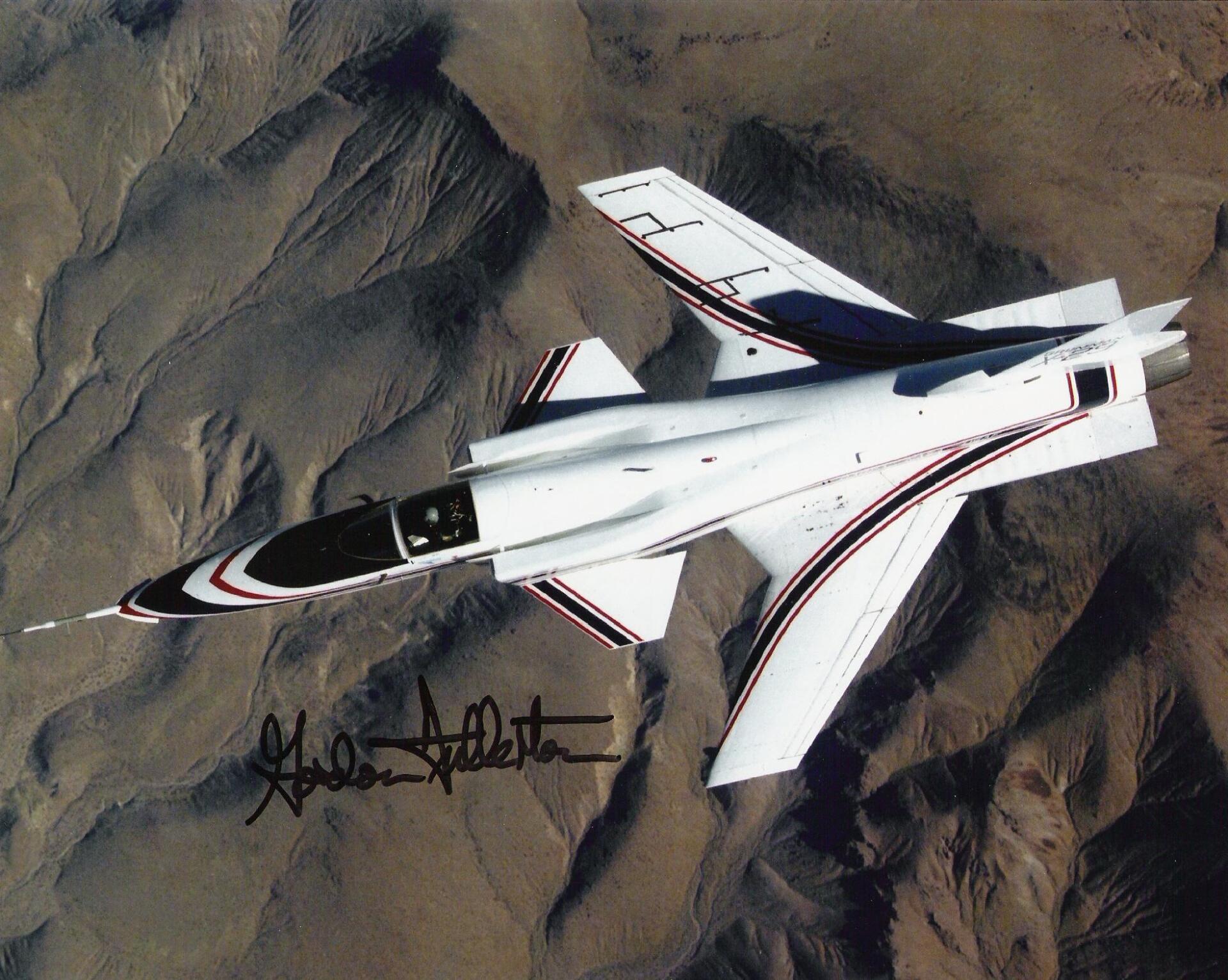
Slide title
Gruman X-29
Button
As a test pilot, Fullerton has over 13,000 hours of flying time, piloting 114 different types of aircraft, including full qualification in the T-33, T-34, T-37, T-39, F-86, F-101, F-106, F-111, F-14, X-29, KC-135, C-140, B-47. Since joining Dryden as a research pilot, Fullerton has piloted nearly all the research and support aircraft flown at the facility and currently flies the T-38, F-18, F-15, B-52, the NASA/Conair 990, 747 Shuttle Carrier Aircraft, and the DC-8. Assigned to evaluate the flying qualities of the Russian Tu-144 supersonic transport during two flights in 1998, he reached a speed of Mach 2 and became one of only two non-Russian pilots to fly that aircraft. Gordon Fullerton is a former NASA astronaut After primary and basic flight school he was trained as an F-86 interceptor pilot, and later became a B-47 bomber pilot at Davis-Monthan AFB, AZ. In 1964 he was chosen to attend the Air Force Aerospace Research Pilot School (now the Air Force Test Pilot School), Edwards AFB, CA. Upon graduation he was assigned as a test pilot with the Bomber Operations Division at Wright-Patterson AFB, OH. In 1966, Fullerton was selected for and served as a flight crew member for the Air Force Manned Orbiting Laboratory program until its termination in 1969.
After assignment to the NASA Johnson Space Center, as an astronaut Fullerton served on the support crews for the Apollo 14, 15, 16 and 17 lunar missions. In 1977, Fullerton was assigned to one of the two two-man flight crews which piloted the Space Shuttle prototype Enterprise during the Approach and Landing Test Program at Dryden that same year and was pilot of the Enterprise on its first free flight along with Commander Fred W. Haise. Fullerton was the pilot on the eight-day STS-3 Space Shuttle orbital flight test mission March 22-30, 1982. Launched from the Kennedy Space Center, FL., the mission exposed the orbiter Columbia to extremes in thermal stress and tested the 50-foot Remote Manipulator System used to grapple and manoeuvre payloads to orbit. STS-3 landed at Northrup Strip, White Sands, NM, because Rogers Dry Lake at Edwards AFB was wet due to heavy seasonal rains. Fullerton was commander of the STS-51F Spacelab 2 mission, launched from the Kennedy Space Center, FL, on July 29, 1985. This mission, with the orbiter Challenger was the first pallet-only Spacelab mission and the first to operate the Spacelab Instrument Pointing System (IPS). It carried 13 major experiments in the fields of astronomy, solar physics, ionospheric science, life science, and a super fluid helium experiment. The mission ended August 6, 1985, with a landing at Dryden. Click here to read Colonel Fullerton's NASA Dryden biography.
Lt. Col. Fitzhugh "Fitz" Fulton USAF ret. - (1925-2015)
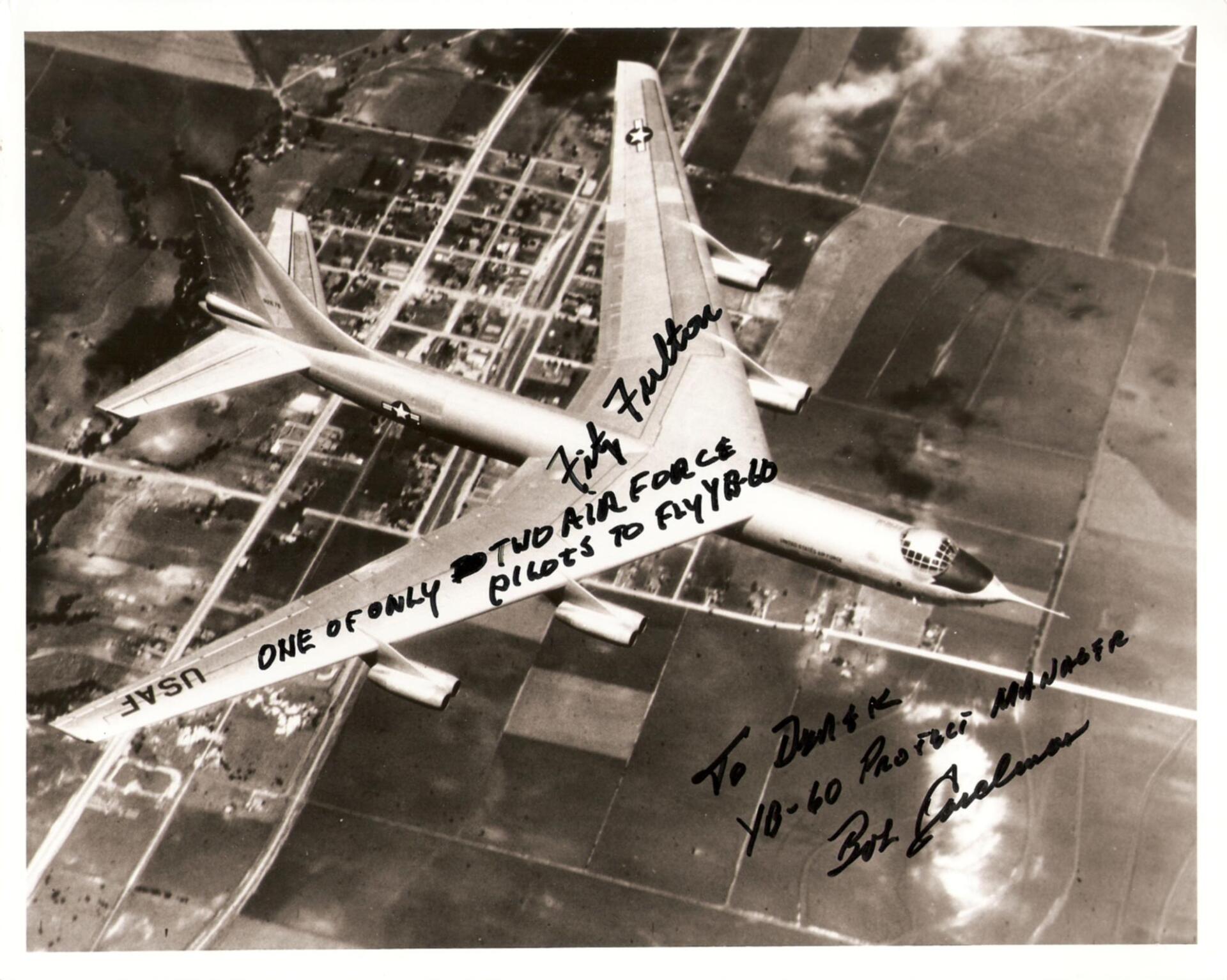
Slide title
Convair YB-60
Button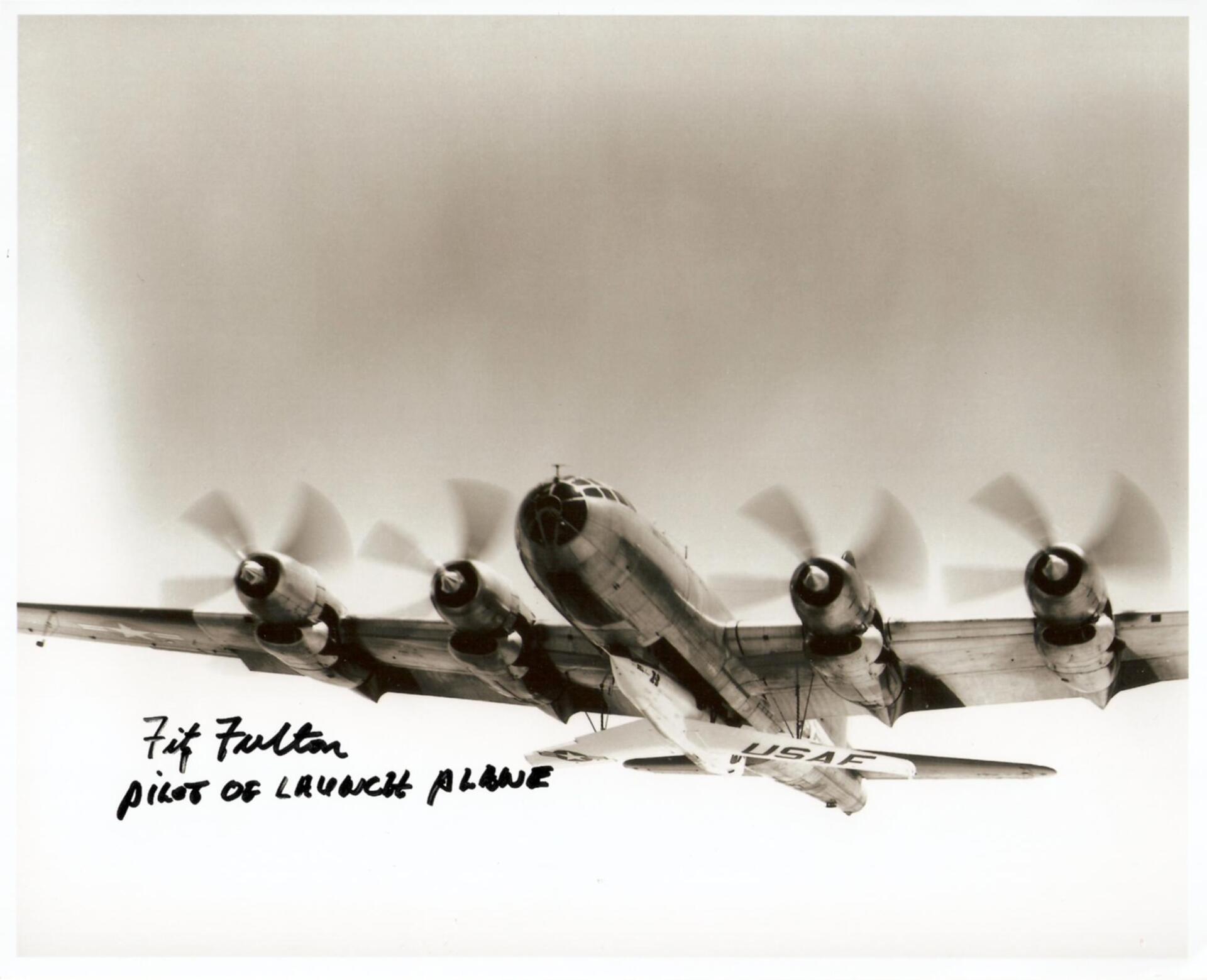
Slide title
B-50 with the X-2 - Fitz is the Father of the Mother Planes
Button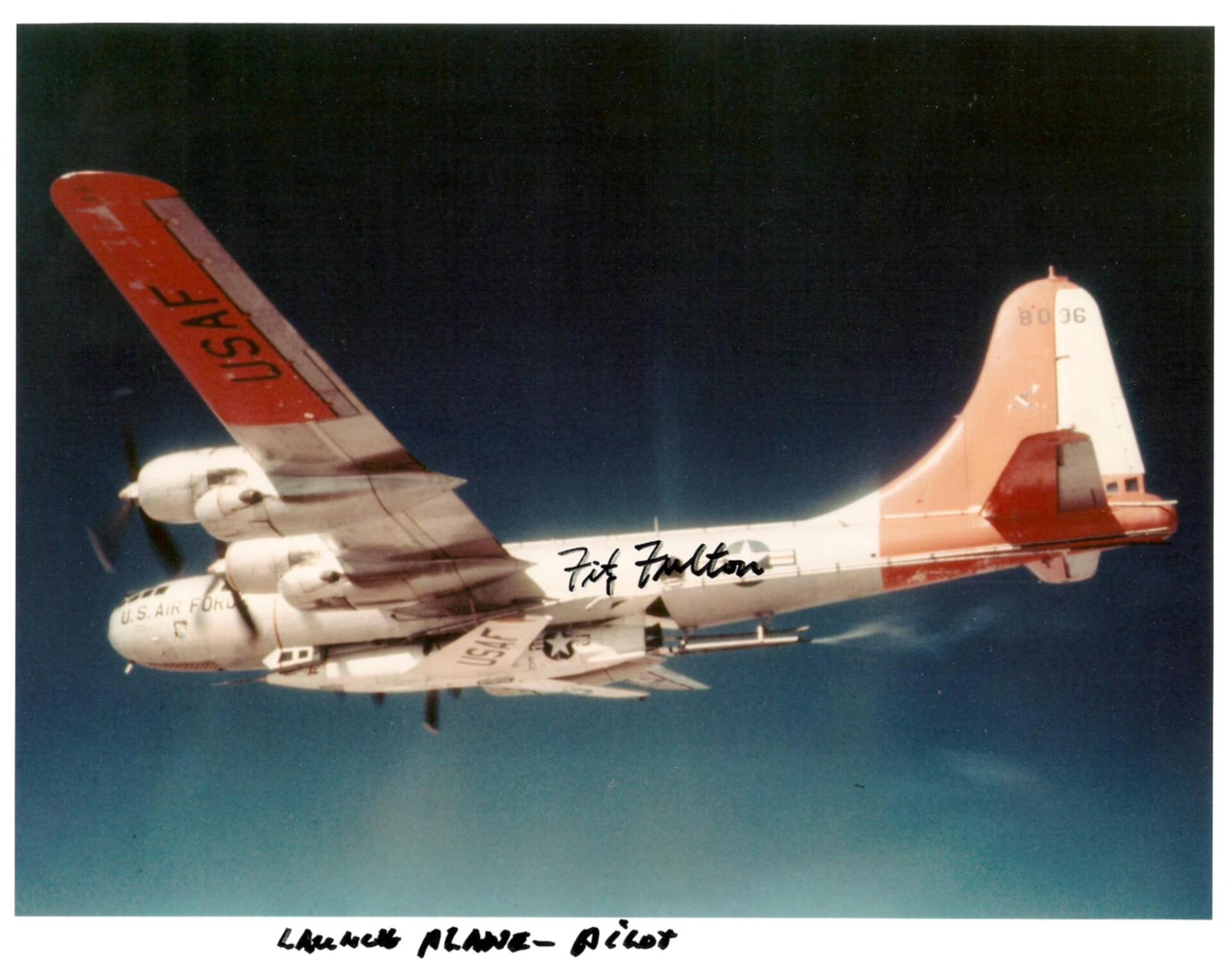
Slide title
B-50 & X-2
Button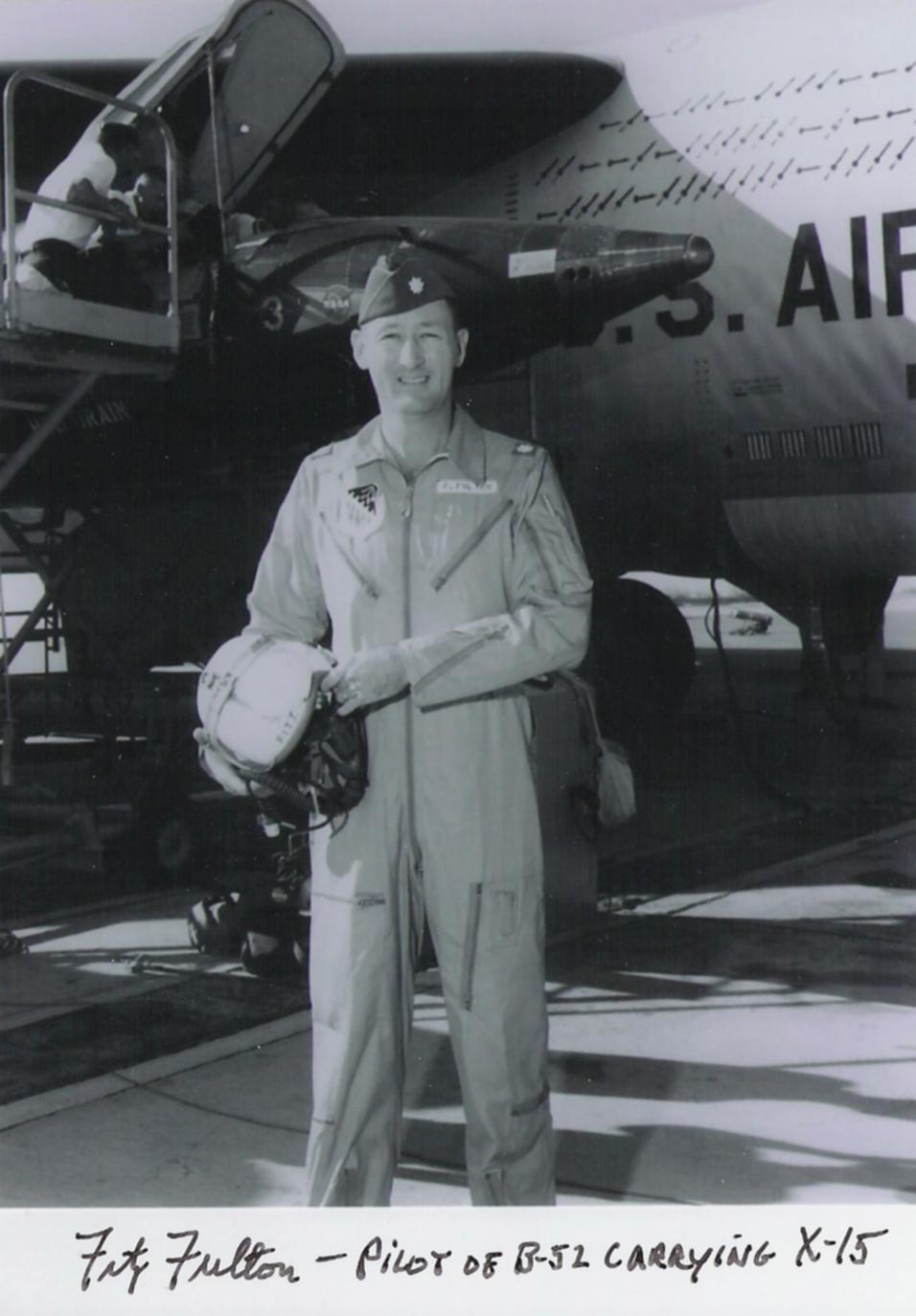
Slide title
NB-52 pilot (with X-15)
Button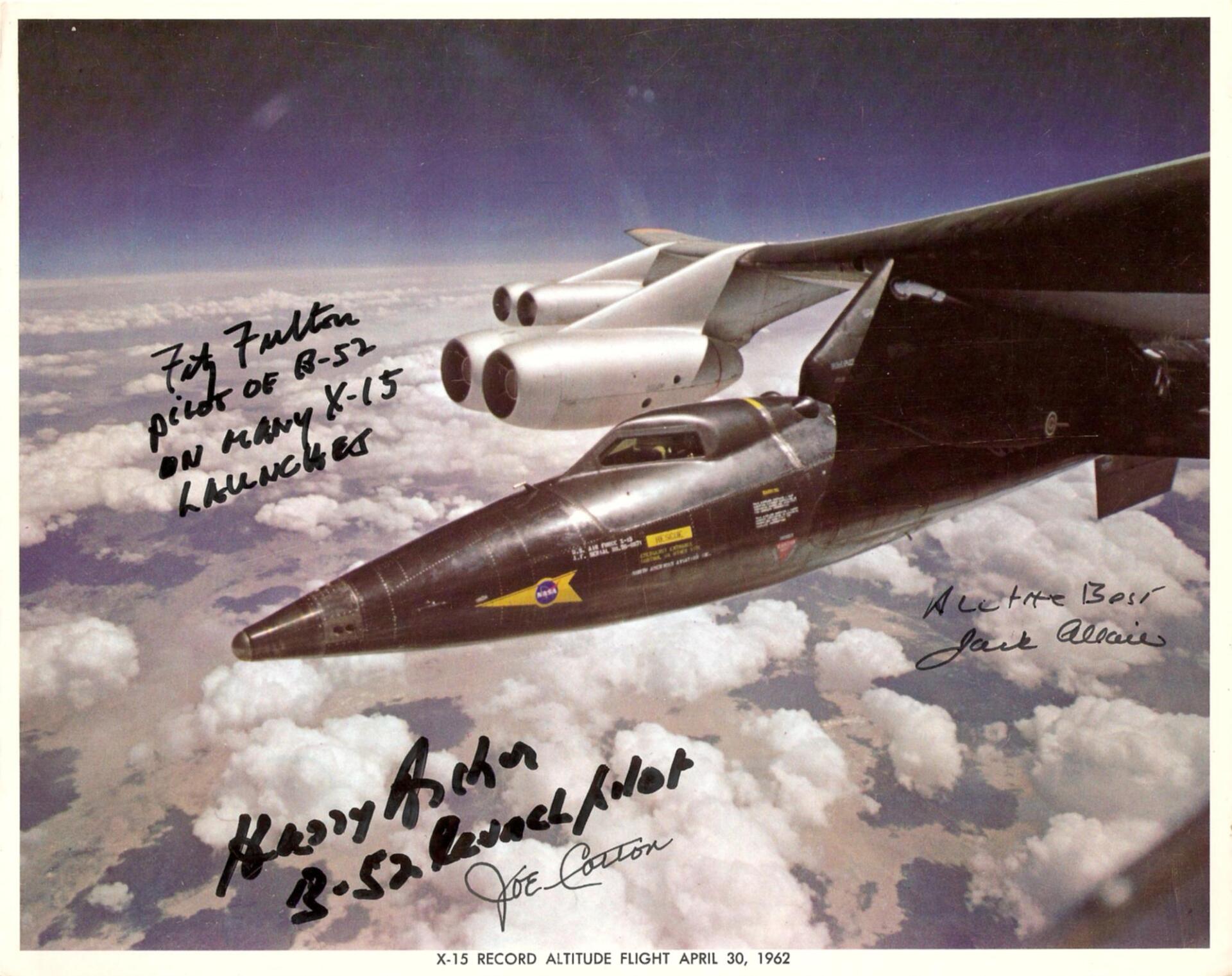
Slide title
NB-52 launch pilots (X-15)
Button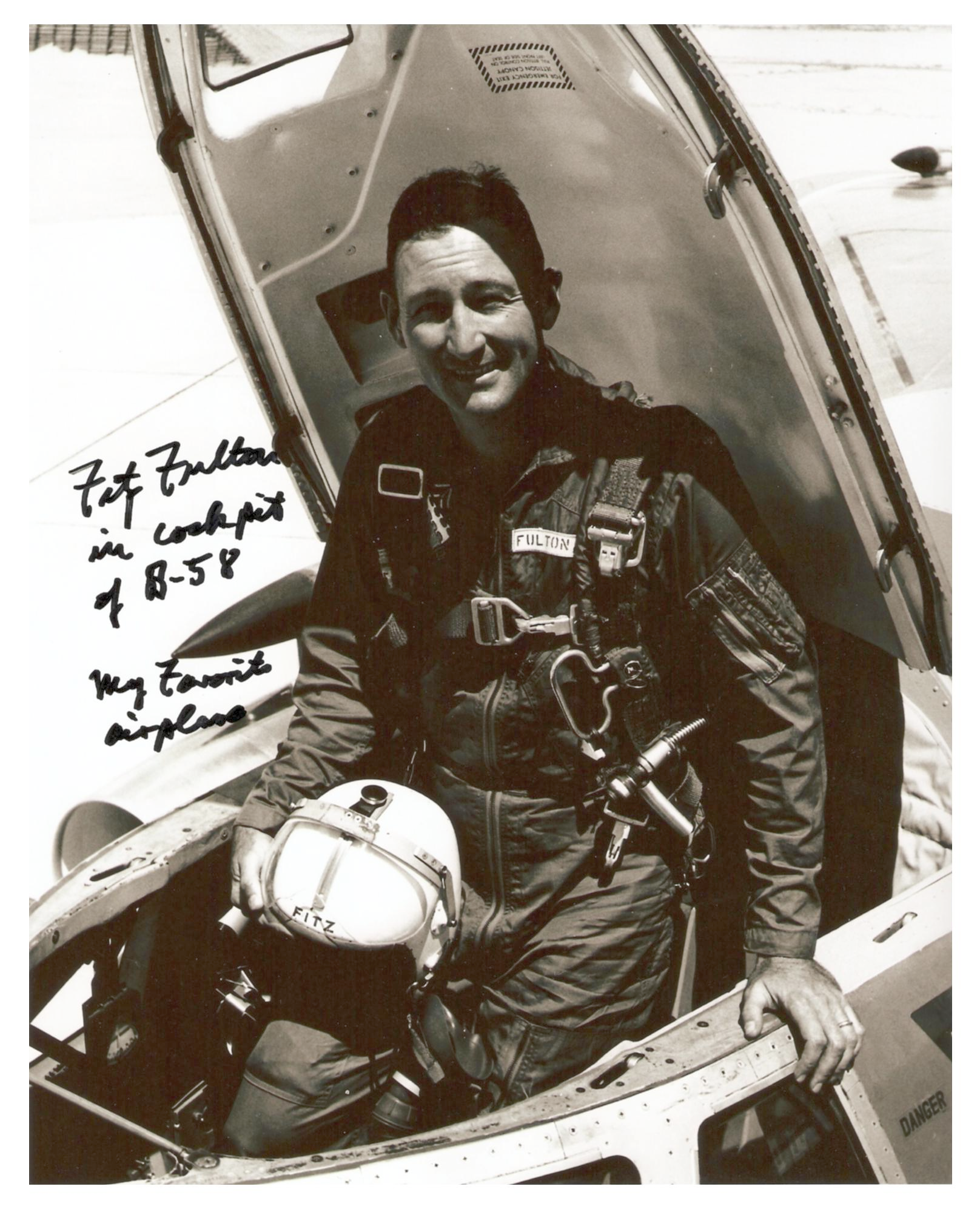
Slide title
Fitz in B-58 cockpit - His favourite plane
Button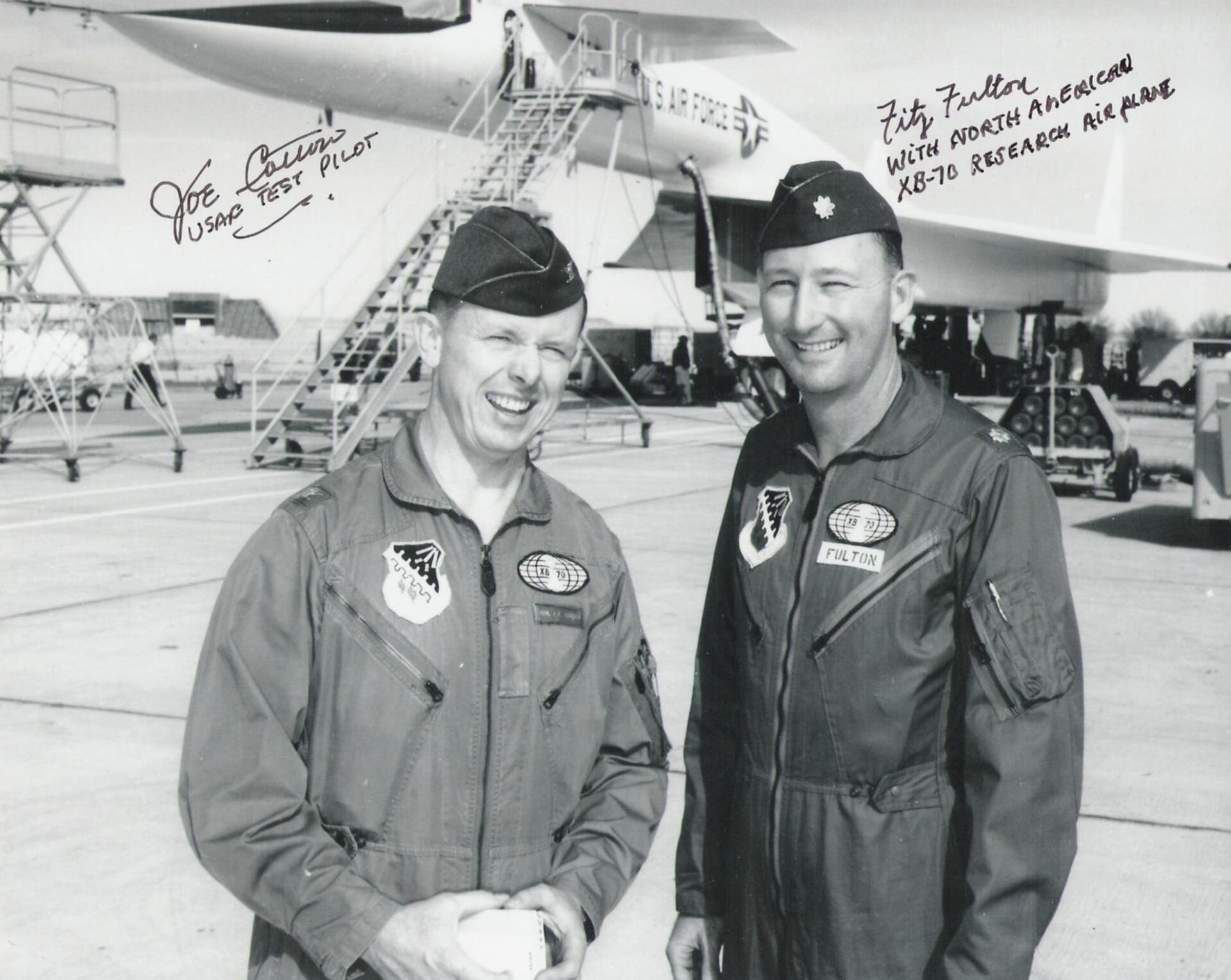
Slide title
Joe Cotton & Fitz - XB-70 pilots
Button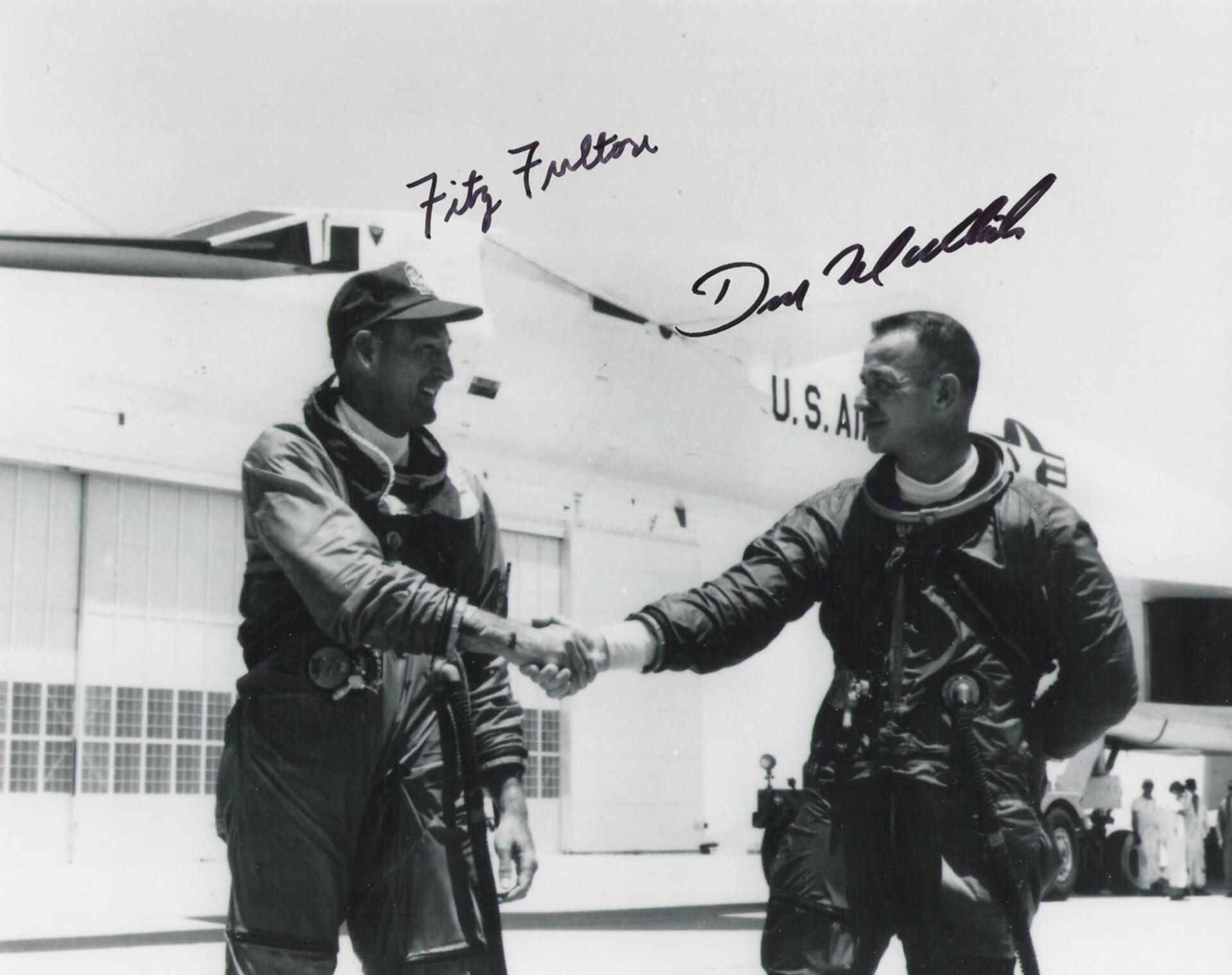
Slide title
Fitz & Don Mallick with XB-70
Button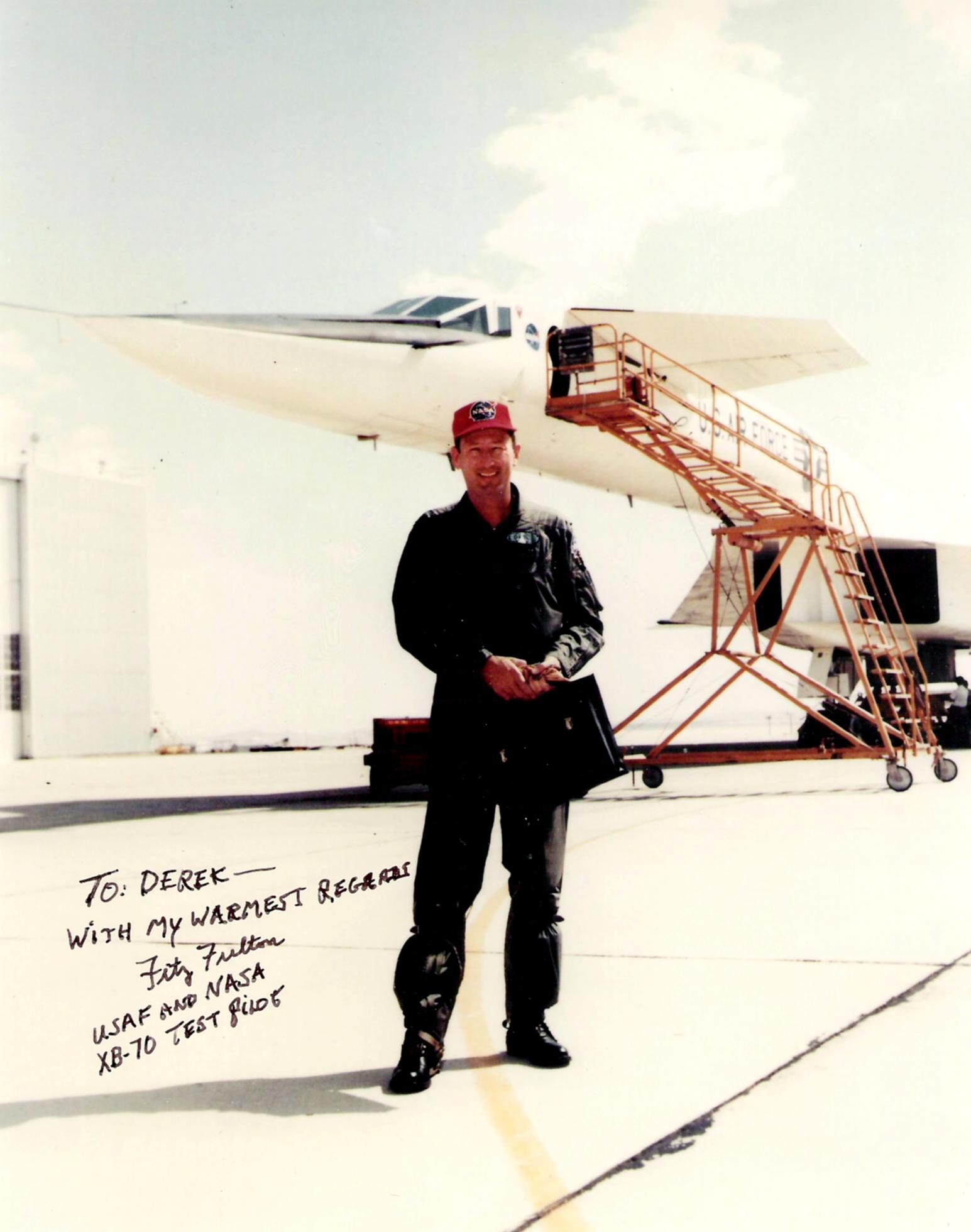
Slide title
Fitz with the XB-70
Button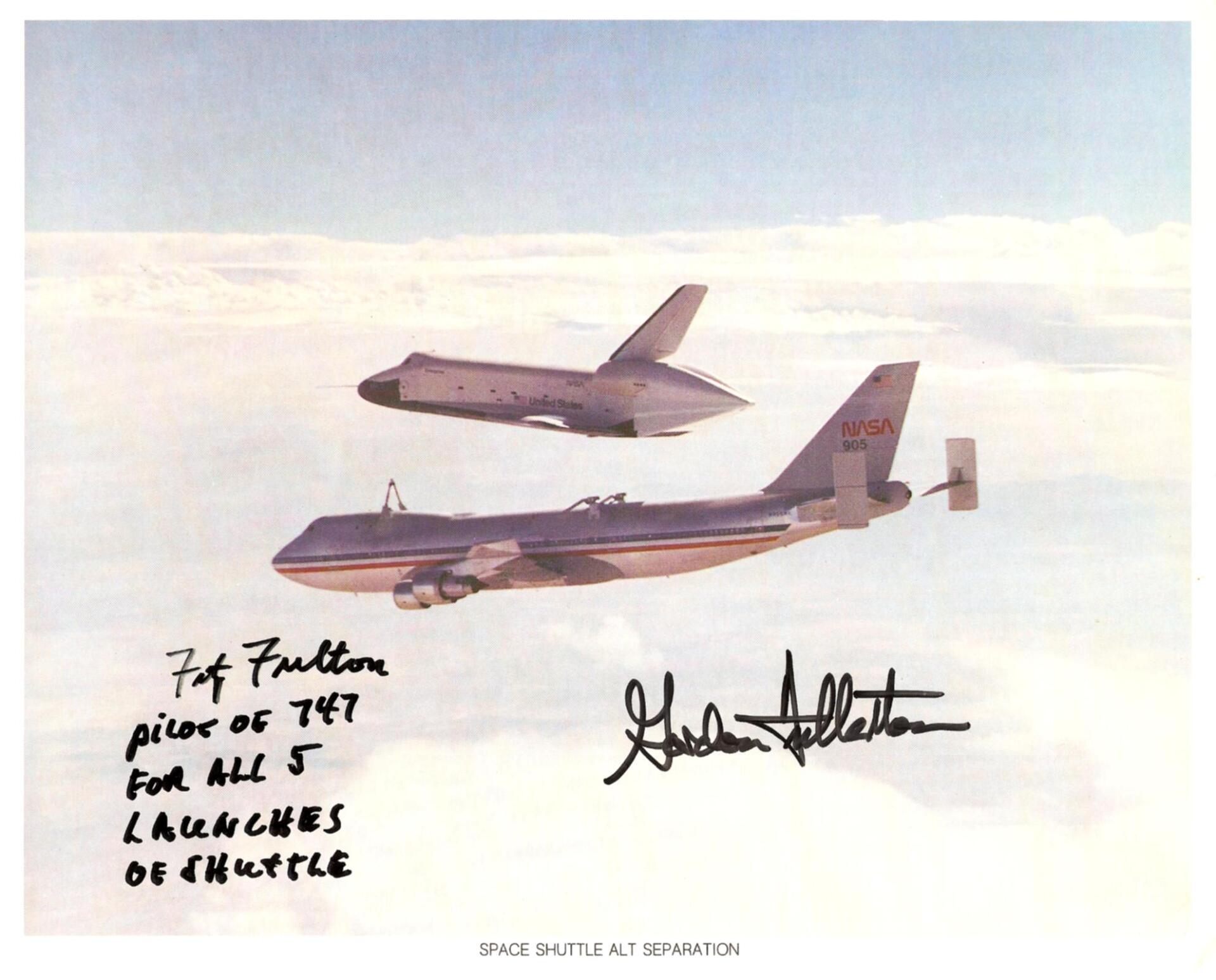
Slide title
ALT seperation
Button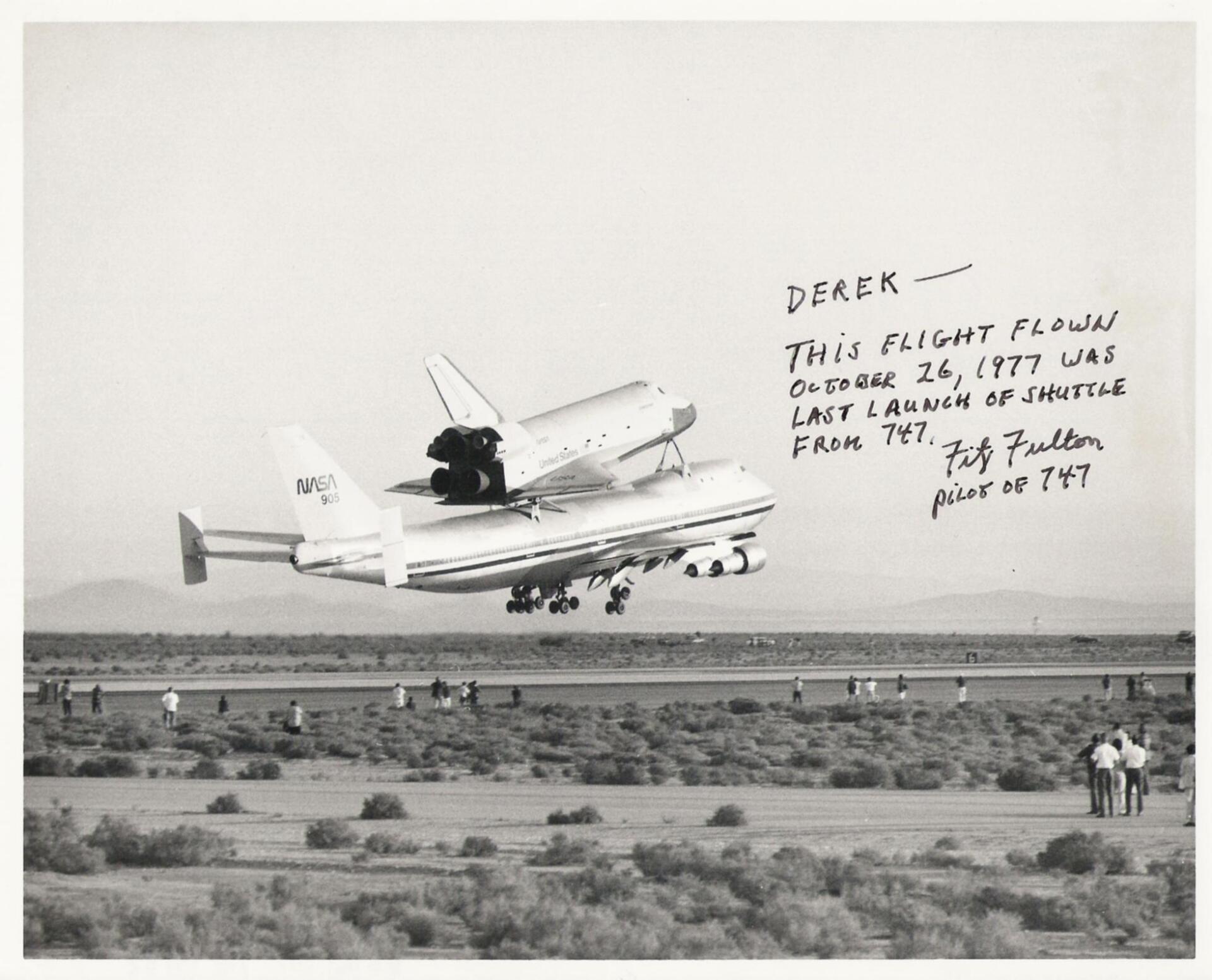
Slide title
Boeing 747 SCA pilot
Button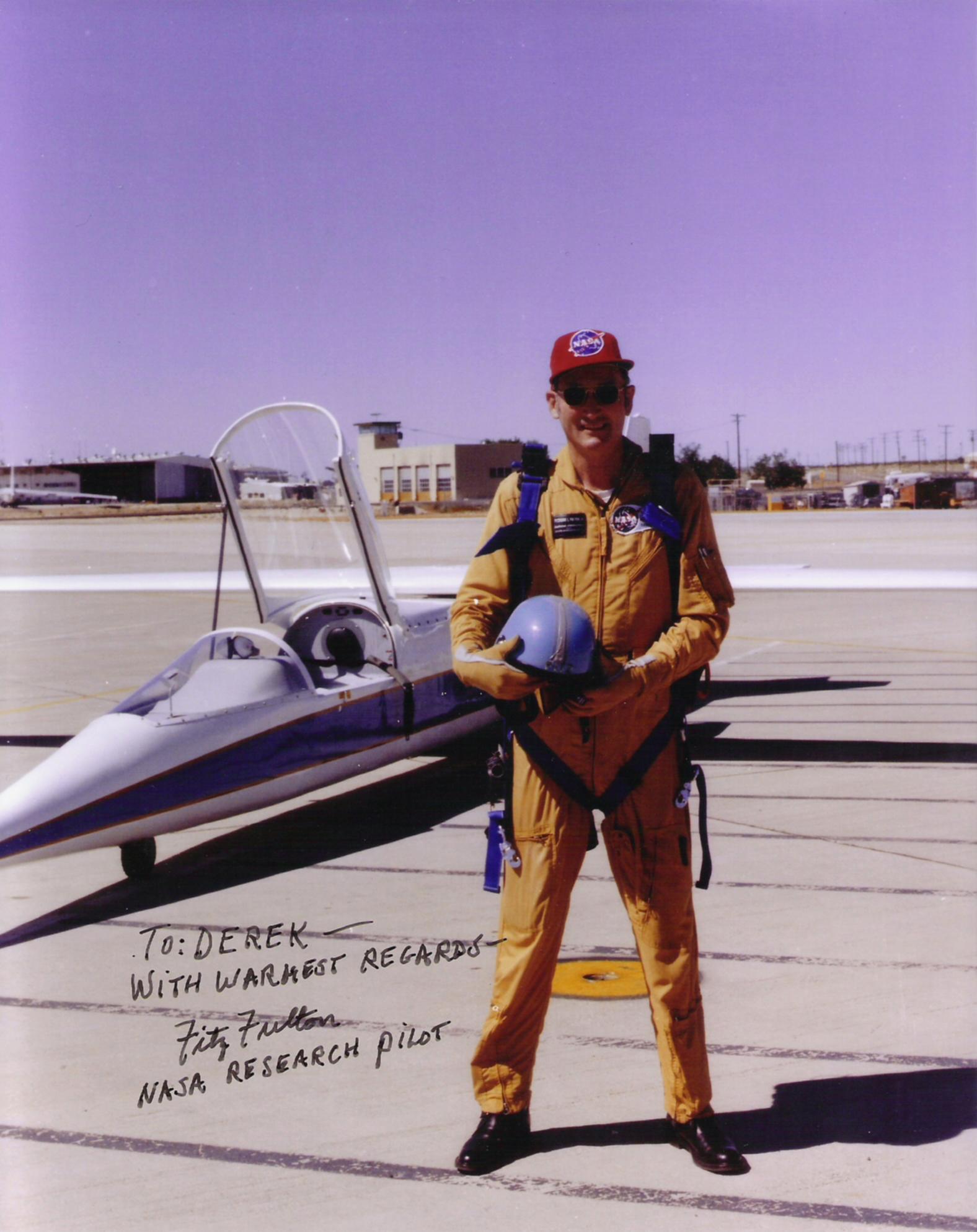
Slide title
NASA AD-1 Oblique Wing
Button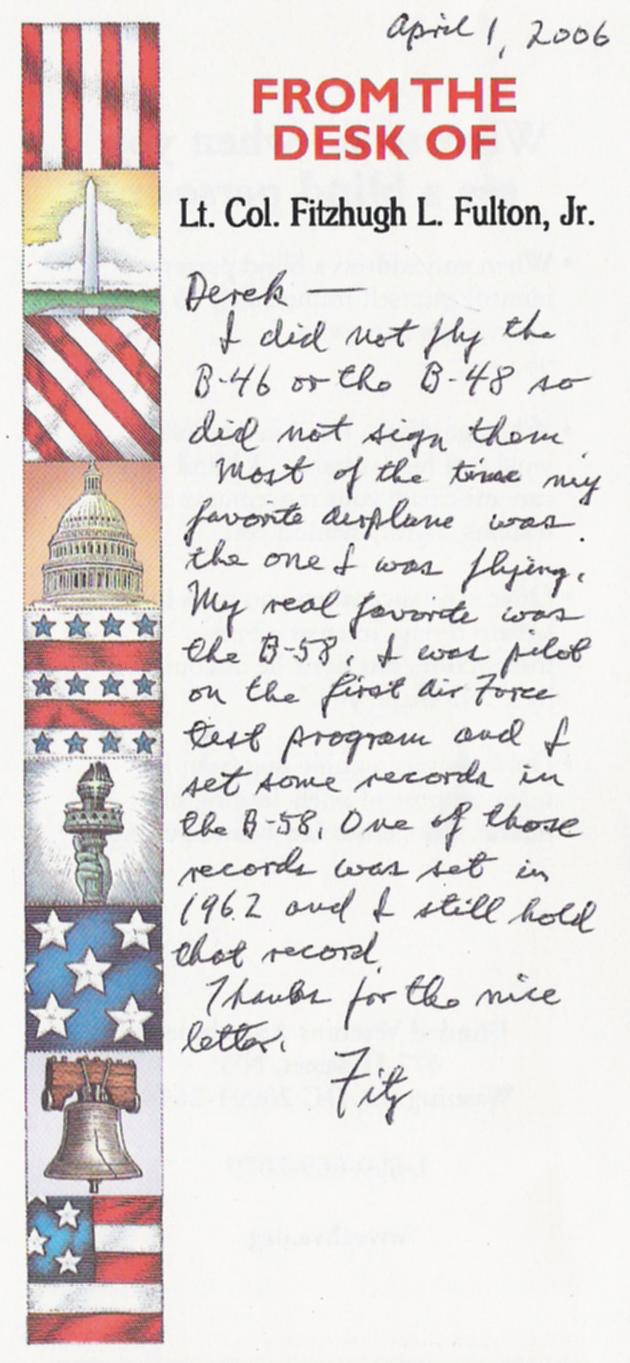
Slide title
Letter from Fitz Fulton
Button
The man who easily holds the record for the longest test piloting career at Edwards is Lt. Col. Fitz Fulton, USAF (Ret). Apart from a year in the Korean conflict and another for university studies, he was engaged in flight test at Edwards continuously from 1950 to 1986, first for the Air Force and then for NASA. In addition to flying as launch pilot for such programs as the X-1, X-2, the Lifting Bodies and, ultimately, the Space Shuttle approach and landing tests with the unpowered Enterprise 1977, he served as project pilot for such aircraft as the B-47, B-52, B-57, B-66, the Mach 2 B-58 and the triple sonic XB-70. From 1970-79, he flew the Mach 3 YF-12 in an extensive series of supersonic research tests for NASA. During a distinguished career, he amassed more than 16,000 flying hours in over 235 different aircraft. Read Fitz Fulton's NASA DFRC biography.
Colonel Jerauld R. "Jerry" Gentry USAF ret. - (1935-2003)
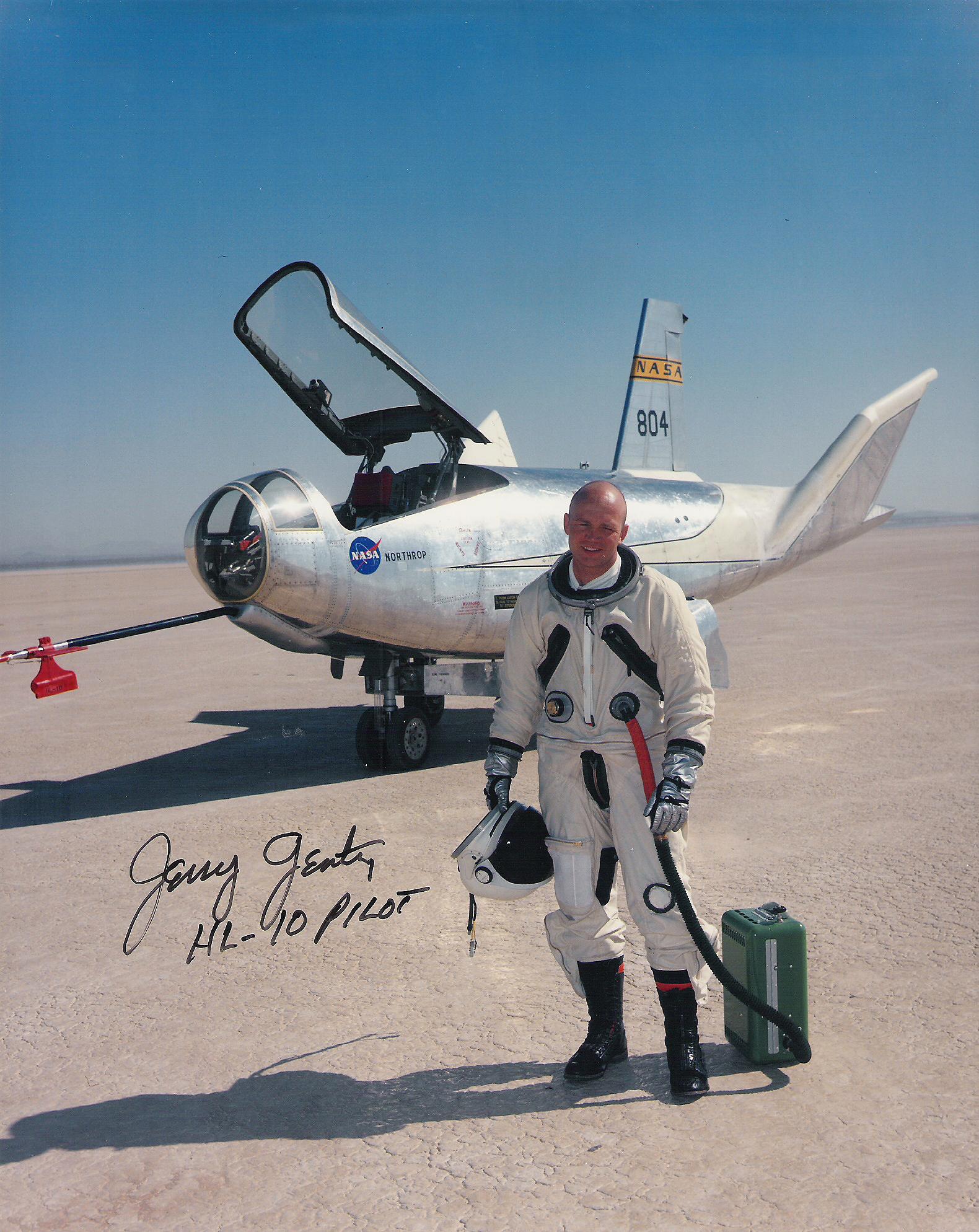
Slide title
Jerry Gentry with the HL-10
Button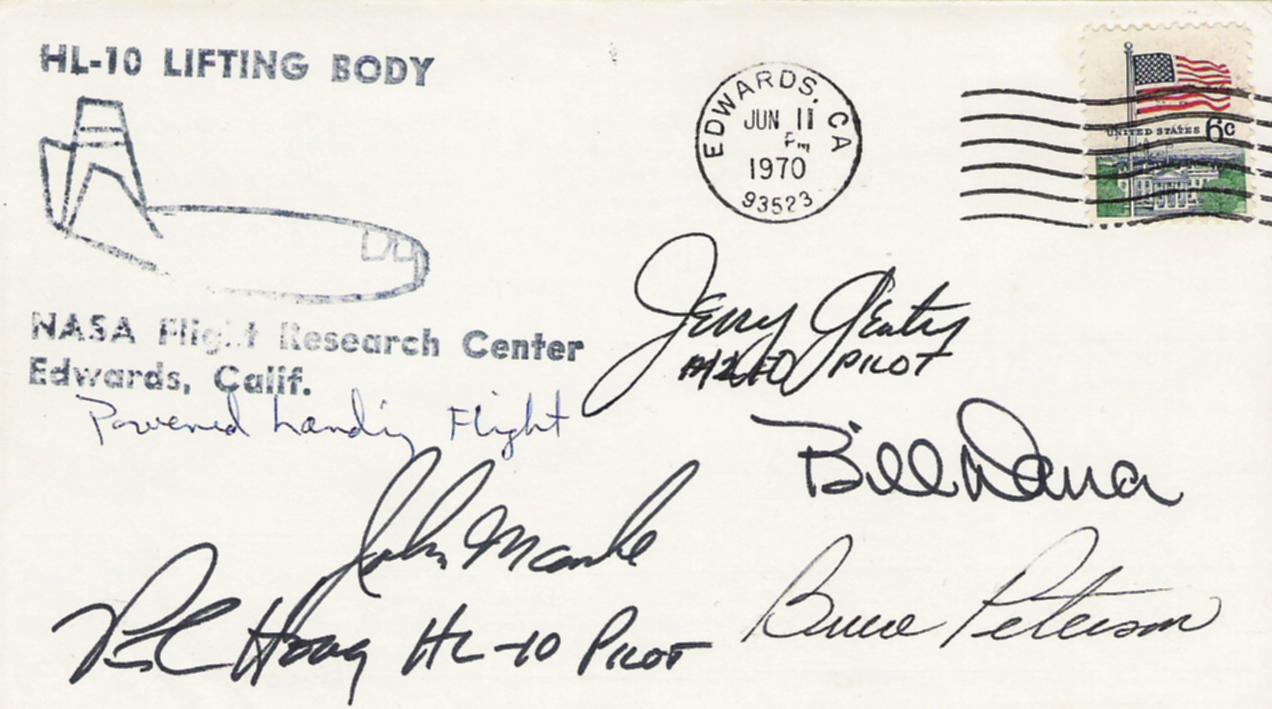
Slide title
HL-10 cover signed by 5 pilots
Button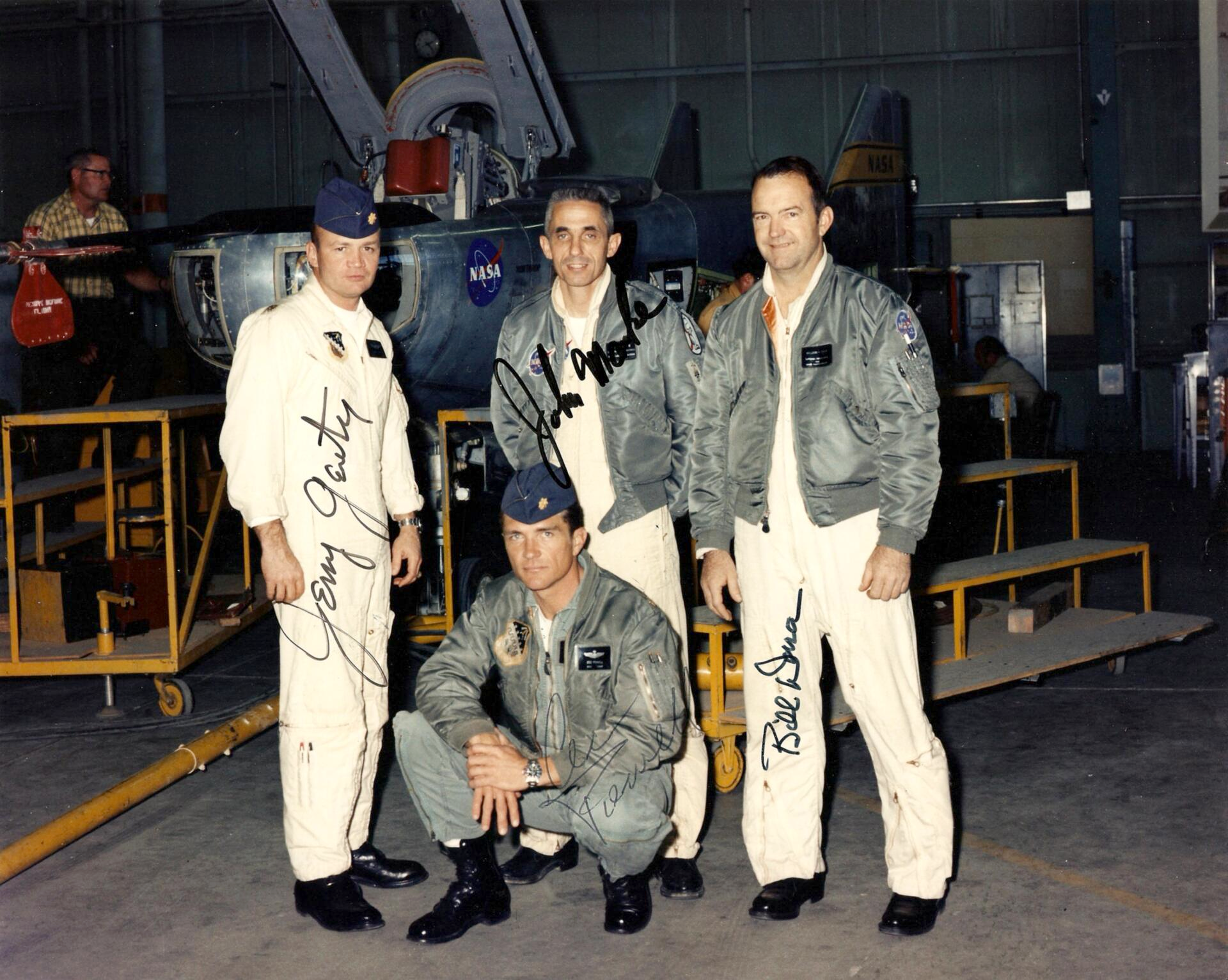
Slide title
M2-F3 pilots Gentry, Powell, Manke & Dana
Button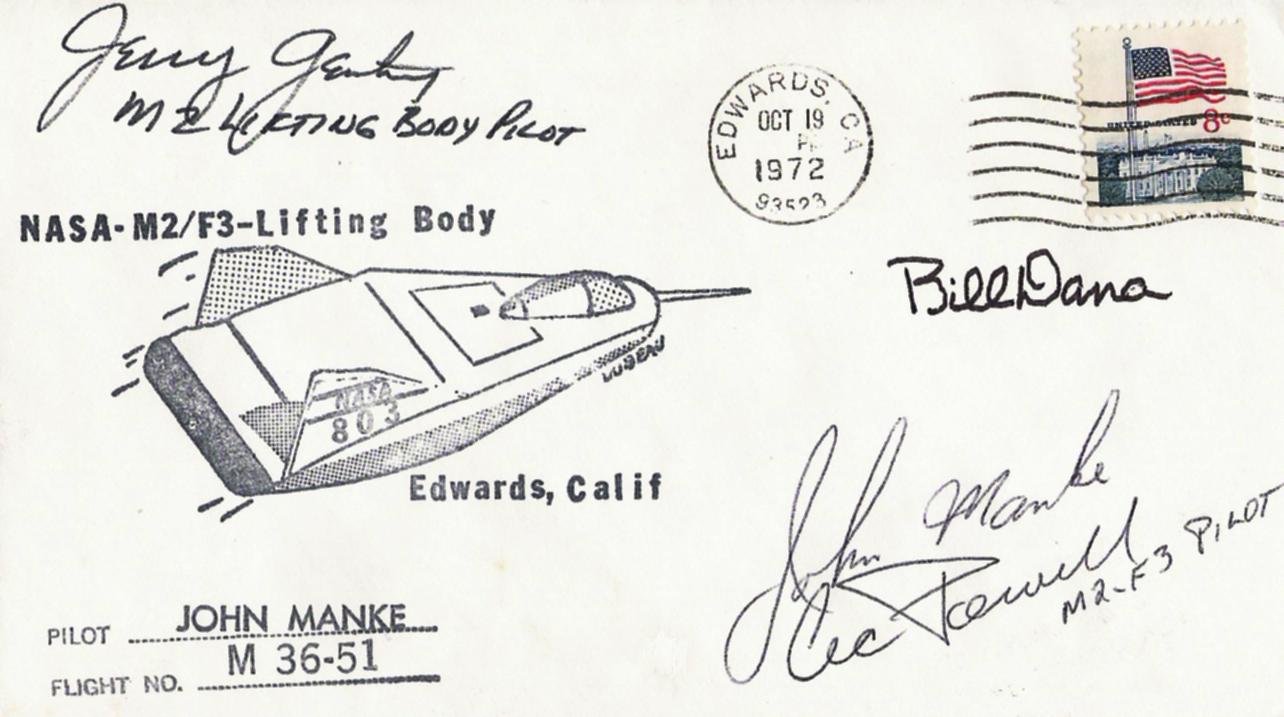
Slide title
M2-F3 cover signed by Gentry, Dana, Manke & Powell
Button
Jerauld Richard "Jerry" is a retired Air Force Colonel and decorated Vietnam War veteran who spent much of his career as a fighter and test pilot. Colonel Gentry, a Washington area resident since 1982, was born in Oklahoma. He was a 1957 graduate of the U.S. Naval Academy at Annapolis and took his commission in the Air Force. He received a master's degree in aerospace systems management from the University of Southern California. He graduated from Aerospace Research Pilot School in 1964, before beginning a seven-year tour at the Air Force Flight Test Center as a test pilot. During that tour, he became chief Air Force pilot with the National Aeronautics and Space Administration in a joint project that led to the space shuttle program and flew many of the experimental "lifting bodies" including the M2-F1, M2-F2, M2-F3, HL-10 and X-24A. In 1971, he went to Thailand and flew more than 200 missions in the F-4D Phantom fighter. Later, he was a leader in the Air Force's lightweight fighter program that led to the development of the F-16 Fighting Falcon. He then served at Nellis Air Force Base in Nevada, where he was a "Red Flag" aerial combat training commander.
He later took command of the first tactical fighter wing to receive the new F-16 fighter. In 1983, he became deputy chief of staff for research, development and acquisitions at Air Force headquarters. After retiring from active duty in 1985, he founded the Alexandria aerospace and defence consulting firm of Gentry and Associates Inc. and remained its head until his untimely death on March 3, 2003 of a heart attack. Colonel Gentry, a command pilot, had flown more than 40 types of aircraft, logging more than 4,700 flying hours. He was a recipient of the Octave Chanute Award and the Harmon International and Ivan E. Kincheloe trophies. His Air Force decorations included the Silver Star, the Legion of Merit, two awards of the Distinguished Flying Cross, three awards of the Meritorious Service Medal and the Air Medal with two silver and three bronze oak-leaf clusters.
Robert J. "Bob" Gilliland - (1926-2019)
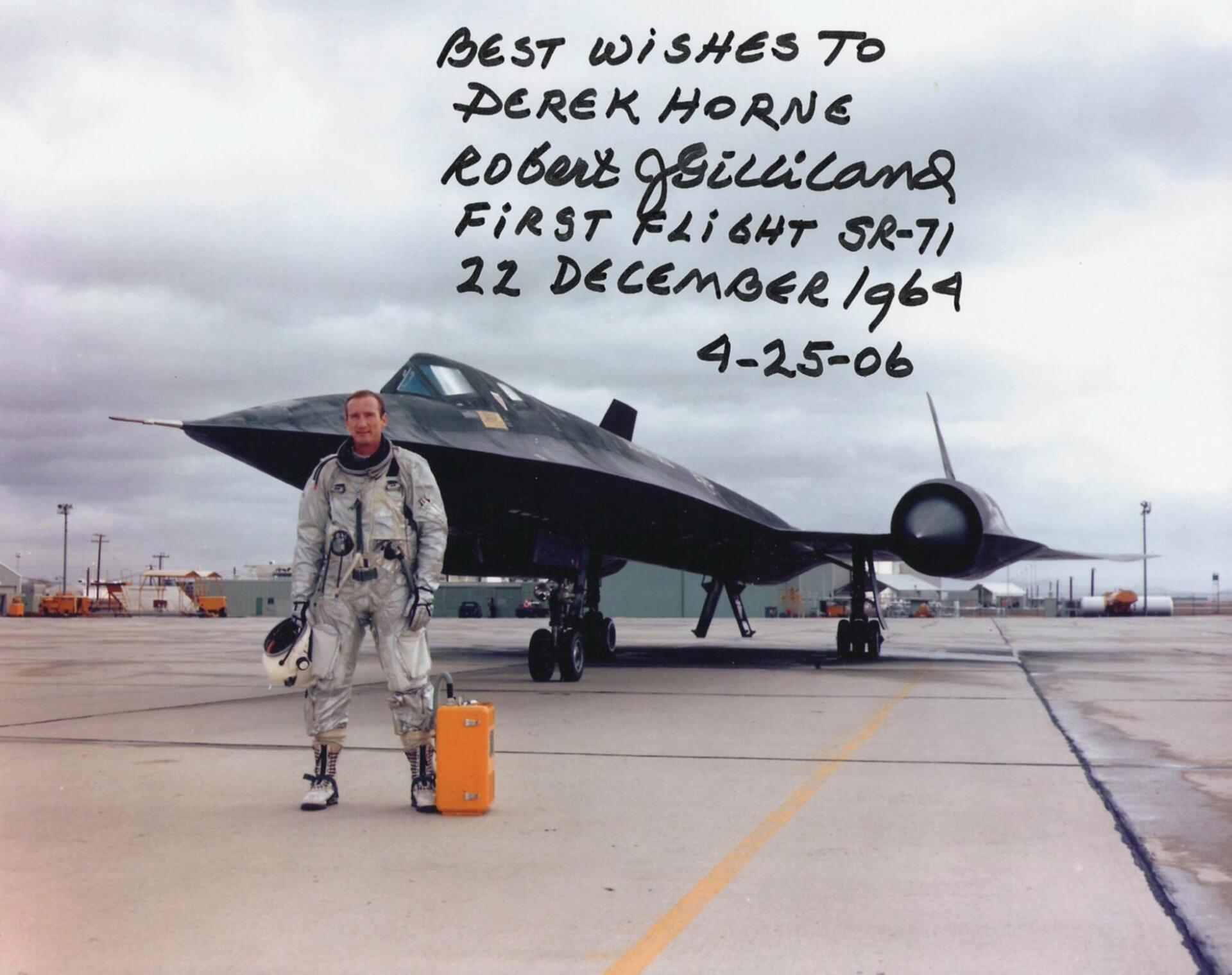
Slide title
Bob Gilliland with the SR-71
Button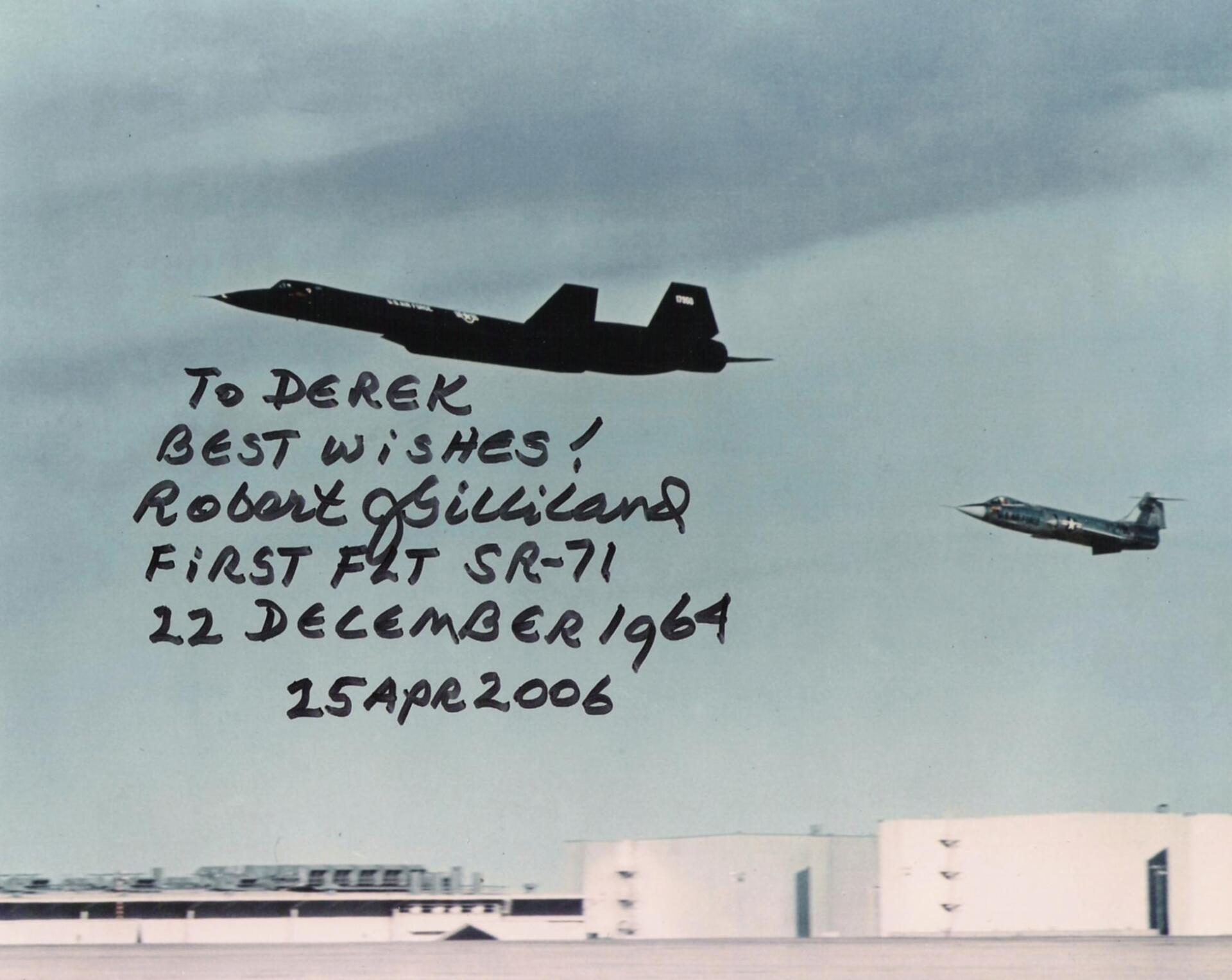
Slide title
First flight of the SR-71
Button
Slide title
SR-71 in flight
Button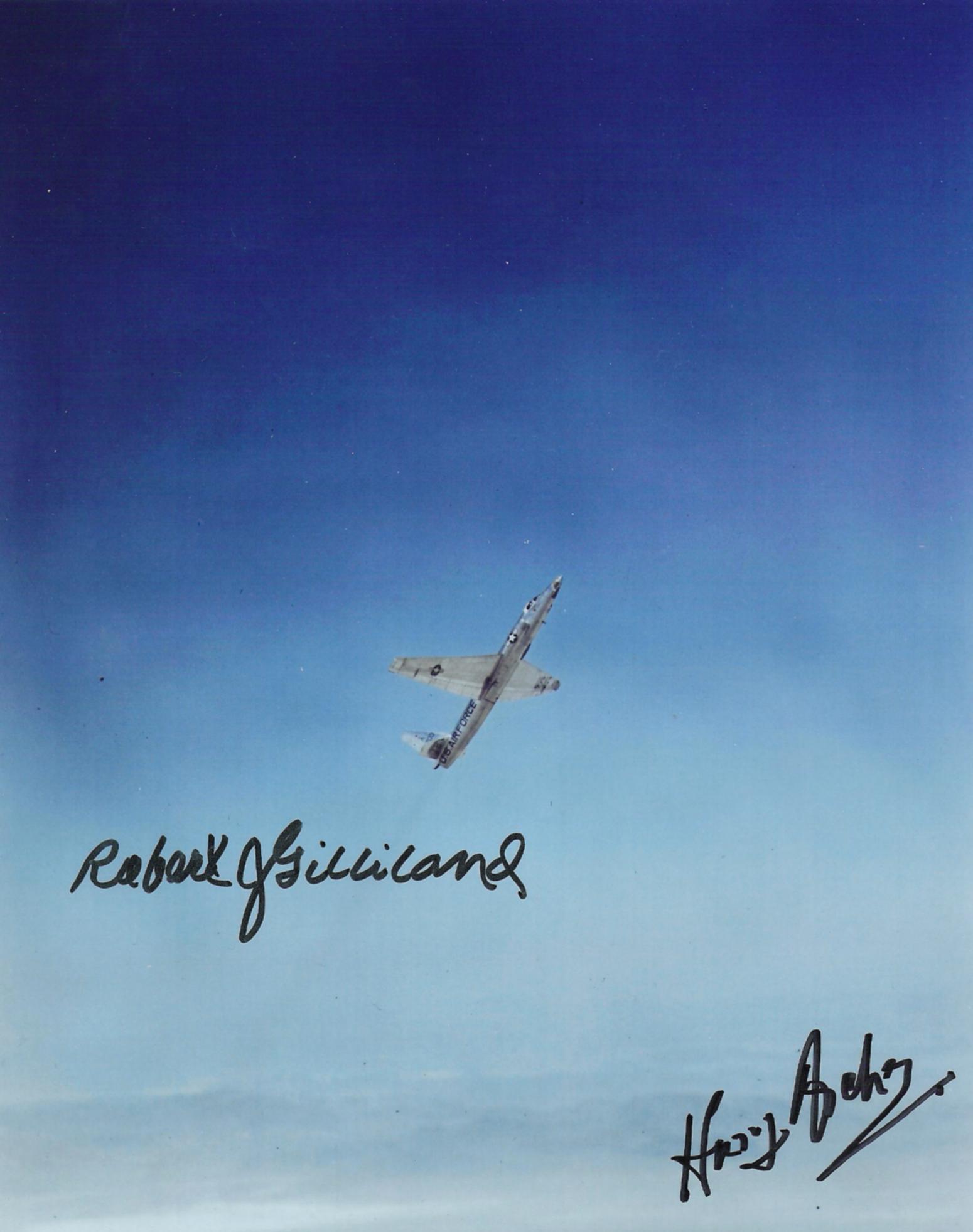
Slide title
Lockheed U-2
Button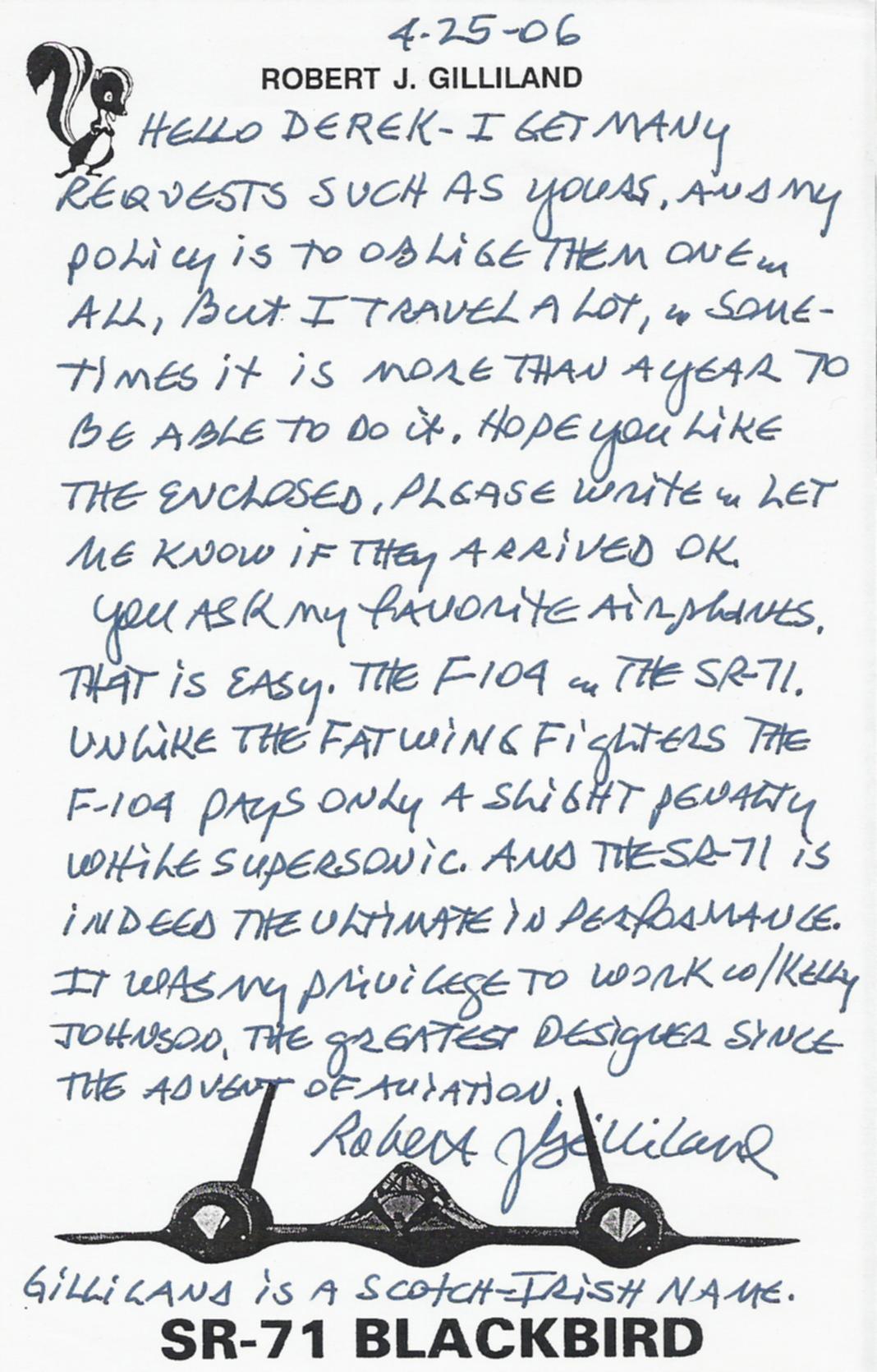
Slide title
Letter I received from Bob Gilliland
Button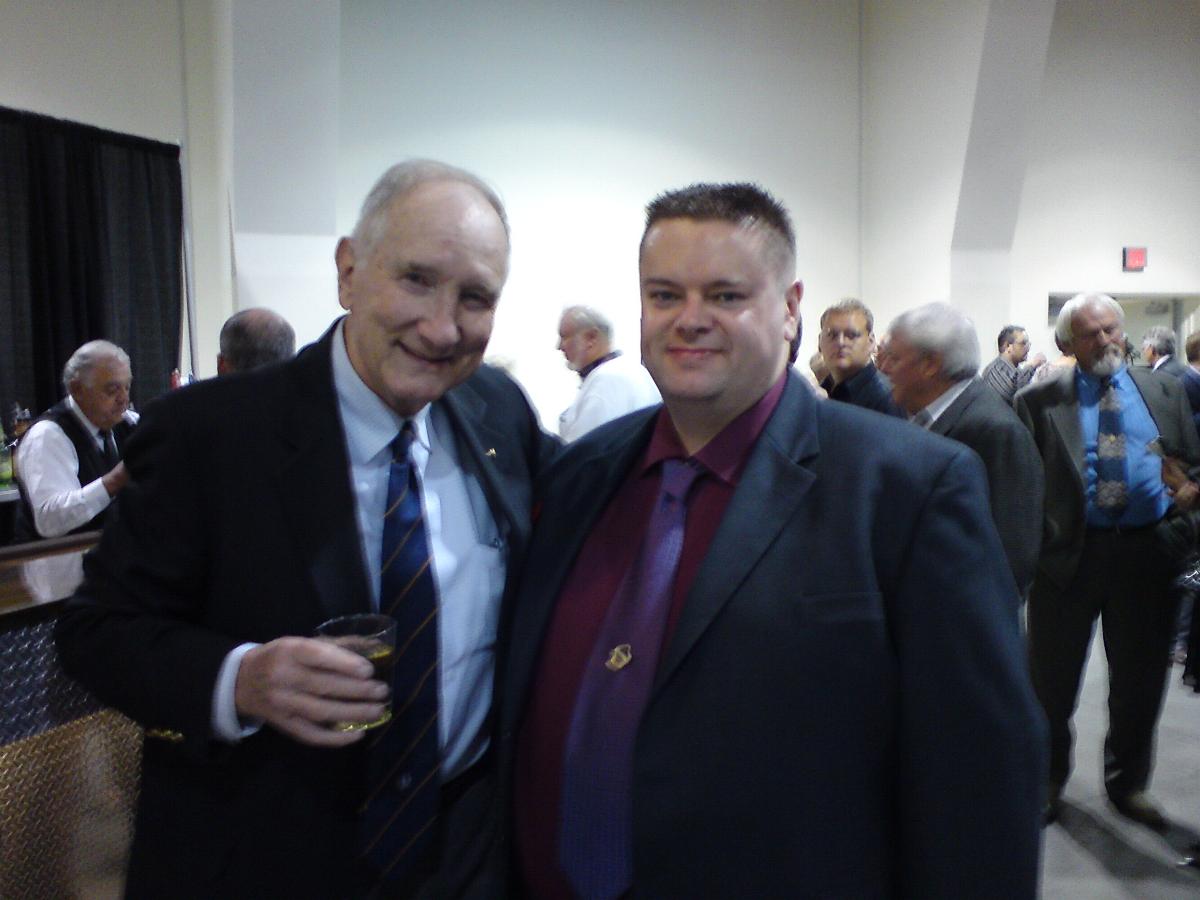
Slide title
The Author with Bob Gilliland at the FTHF's "Gathering of Eagles" in California, October 16th 2009
Button
Robert J. Gilliland, the first man to fly the SR-71 Blackbird, has logged more experimental supersonic flight test time above Mach 2 and Mach 3 than any other pilot. A sailor in World War II and a 1949 Naval Academy graduate, Gilliland joined the newly formed United States Air Force. After flying P-47 Thunderbolts and F-84 Thunderjet's in Germany, he flew F-84s during a combat tour in Korea in 1952. His first test flight was measuring the wing loads of the Thunderjet. When he finished, he analysed the flight saying, "The wing didn't come off, so I felt pretty good." As a fighter test pilot in 1953 at Eglin Air Force Base, Florida, he flew most of the aircraft in the Air Force inventory. Later, he joined Lockheed as a civilian test pilot flying the F-104 Starfighter. In 1962, Gilliland began to test the fastest and highest flying airplanes, including the A-11/A-12, YF-12A and the SR-71. He made the first flight of the SR-71 on December 22, 1964, taking the aircraft to Mach 1.5 and 50,000 feet altitude. He served as the principal test pilot for the SR-71's development program.
He logged over 6,500 hours in many different aircraft, including the F-104, F-80, F-84, F-86, T-6, P-47, YF-12A and SR-71. A Fellow in the Society of Experimental Test Pilots, Gilliland was awarded the Iven C. Kincheloe Award in 1964 for his work on the Blackbird program. He was named an Eagle by the Air Force Flight Test Historical Foundation in 1998 and received the Godfrey L. Cabot Award in 2001. He is a trustee of the Association of Naval Aviation. Bob Gilliland was born in Memphis, Tennessee in 1926 and splits his time between Tennessee and Burbank, California. He has a son and a daughter. He speaks fondly of the lifelong flying friendships he formed at Edwards Air Force Base and promises the test pilot of the future that there will always be opportunities on the cutting edge of flight test in spite of the Unmanned Aerial Vehicles. The United States will always have a need for pilots who are challenged by the inherent danger of the work. Does the danger bother him? "The work is exciting. You may get killed. So what!" he responded.
